
About UsThe Numismatic Bibliomania Society is a non-profit association devoted to the study and enjoyment of numismatic literature. For more information please see our web site at coinbooks.org SubscriptionsThose wishing to become new E-Sylum subscribers (or wishing to Unsubscribe) can go to the following web page link MembershipThere is a membership application available on the web site Membership Application To join, print the application and return it with your check to the address printed on the application. Print/Digital membership is $40 to addresses in the U.S., and $60 elsewhere. A digital-only membership is available for $25. For those without web access, write to: Charles Heck, Treasurer AsylumFor Asylum mailing address changes and other membership questions, contact Chuck at this email address: treasurer@coinbooks.org SubmissionsTo submit items for publication in The E-Sylum, write to the Editor at this address: whomren@gmail.com
BUY THE BOOK BEFORE THE COIN |
- WAYNE'S WORDS: THE E-SYLUM OCTOBER 25, 2020
- ALAIN POINSIGNON NUMISMATIC LIBRARY BOOKPLATES
- RARE BOOKS & FINE ARTS E-AUCTION 7 ANNOUNCED
- REINER SEUPEL ISLAMIC NUMISMATIC LITERATURE LOTS
- NEW BOOK: STANDARD CATALOG OF ECUADORIAN COINS
- NEW BOOK: COINAGE IN EARLY ENGLISH LITERATURE
- NEW BOOK: PAPER MONEY OF RHEINHESSEN 1793-1948
- BANKNOTE BOOK PERU CHAPTER PUBLISHED
- RESEARCH & PUBLISH A NUMISMATIC BOOK
- 1893 ASSAY MEDAL LETTER ON NEWMAN PORTAL
- VIDEO: THE LIFE OF ADAM BREWER
- NOTES FROM E-SYLUM READERS: OCTOBER 25, 2020
- BANK OF ENGLAND MUSEUM AUDIO HIGHLIGHTS
- STONE MOUNTAIN DISTINGUISHED SERVICE MEDAL
- VOCABULARY TERM: HEAT TREATING
- JOHN WHITE HASELTINE (1838-1925)
- HARVEY STACK'S NUMISMATIC FAMILY, PART 81
- STACK’S BOWERS GALLERIES OPENS NEW YORK LOCATION
- VAN RYZIN UPDATES 1913 LIBERTY NICKEL RESEARCH
- ANS 2020 HUNTINGTON AWARD TO SYD MARTIN
- COIN WORLD'S MOST INFLUENTIAL PEOPLE SURVEY
- ANA'S 2021 SERVICE AWARD NOMINATIONS SOUGHT
- HOLABIRD FALL 2020 SALE SELECTIONS
- ARCHIVES INTERNATIONAL AUCTION 62 SELECTIONS
- COLTRANE WAR OF 1812 TREASURY NOTES
- PARTRICK COLLECTION OF CONNECTICUT COPPERS
- READING ANCIENT GREEK COINS
- TOURIST FINDS MEDIEVAL SILVER COIN CACHE
- SILVER PENNY OF BARON EUSTACE FITZJOHN
- MAINE METAL DETECTORIST FINDS 1798 LARGE CENT
- LITHUANIA EURO COIN WITH HEBREW LETTERS
- QUEEN’S BEASTS VS. AMERICA THE BEAUTIFUL
- KELLOGG & HUMBERT GOLD INGOT
- LOOSE CHANGE: OCTOBER 25, 2020
- NEW BOOK: DARK ARCHIVE
- FEATURED WEB PAGE: PERUVIAN BANKNOTES
Click here to access the complete archive
Click here to unsubscribe (scroll down)
To comment or submit articles, reply to whomren@gmail.com
Content presented in The E-Sylum is not necessarily researched or independently fact-checked, and views expressed do not necessarily represent those of the Numismatic Bibliomania Society.
WAYNE'S WORDS: THE E-SYLUM OCTOBER 25, 2020
 New subscribers this week include:
Ty Gardner,
Taylor Dixon, courtesy of Ty Gardner;
and
David Lescarini.
Welcome aboard! We now have 6,595 subscribers.
New subscribers this week include:
Ty Gardner,
Taylor Dixon, courtesy of Ty Gardner;
and
David Lescarini.
Welcome aboard! We now have 6,595 subscribers.
Thank you for reading The E-Sylum. If you enjoy it, please send me the email addresses of friends you think may enjoy it as well and I'll send them a subscription. Contact me at whomren@gmail.com anytime regarding your subscription, or questions, comments or suggestions about our content.
This week we open with three numismatic literature sales, four new books, updates from the Newman Numismatic Portal, and more.
Other topics this week include Assay Commission medals, the Stone Mountain Distinguished Service medal, heat treating, Stack's Bowers' new NYC location, the 1913 Liberty nickels, hobby awards, four auction sales, reading Greek coins, Peruvian banknotes and a couple of really big ingots.
To learn more about bookplates, currency in Bahrain, Ecuadorian coins, how to publish a numismatic book, the Cohen Mint, a Hajj token, the Bank of England Museum, coin dealer John W. Haseltine, collector Fred Knobloch, the most influential people in numismatics, the Carson City Mint, and War of 1812 Treasury notes, read on. Have a great week, everyone!
Wayne Homren
Editor, The E-Sylum
ALAIN POINSIGNON NUMISMATIC LIBRARY BOOKPLATES
As noted last month, Künker's auction 342 in November will feature the research library of French coin dealer Alain Poinsignon. This press release discusses some highlights of the collection through the lens of the bookplates of previous owners. -Editor
On 2 and 3 November 2020, auction house Künker in Osnabrück will auction off the library of coin dealer Alain Poinsignon. Just like every great library, it contains books that were previously owned by other numismatists and coin collectors. Bookplates tell this story. And we tell some stories about the bookplates.
Even in medieval monasteries, the most precious codices did not simply lay on the shelves but were chained to lecterns. This made a basic need of every enthusiastic reader impossible to satisfy: acquiring the book with which one had such an affectionate relationship. A bookplate, or ex-libris (Latin for “ex” and “libris”, thus “from the books of”), is the modern way of chaining books. It makes it more difficult to snatch a book from a library because every time the book is opened, the reader immediately sees who its actual owner is.


Auction 342, Lot 111: The ex-libris of husband and wife Moses and Mary Finley, stuck into a rare book by J. M. F. May, The Coinage of Damastion. Oxford (1939). Estimate: 125 euros
The oldest bookplates can be traced back to the end of the 15th century. They experienced their first golden age in the Renaissance period, when they became a status symbol. People carefully thought about what to depict on them. Even highly renowned artists such as Albrecht Dürer, Lucas Cranach or Hans Holbein did not believe that designing ex-libris was beneath their dignity. Since then, bookplates have never ceased to exist. However, there were obviously times during which they were more or less common.
The fascination of ex-libris lies in the fact that they summarise on a few square centimetres what their owner considered to be especially remarkable about his personality. And this can have much to do with their lives, as the bookplate of world-famous historian Moses Finley demonstrates. Of course, Athena refers to the period he focused on in his research. However, much more remarkable is the fact that there was an ex-libris in his “own” books bearing not only his name but also that of his wife. Despite being childless, he led a fulfilled and happy life with her. How close their relationship was after more than 50 years of marriage is illustrated by the fact that Moses Finley suffered a stroke one hour after discovering that his wife had passed away, and he died the following day.


Auction: 342, Lot 1: Pierre Bastien’s bookplate, stuck into the extremely rare publication on the collection of Carlos de Beistegui. Paris (1933). Estimate: 750 euros
Thus, ex-libris illustrate the personality of their creator and depict them as they liked to see themselves. That is the reason why even someone who hasn’t read any of Pierre Bastien’s more than 180 works can tell from the shape and the motif of his ex-libris that numismatics played an important role in his life. The depiction of Hygieia refers to Bastien’s bread-and-butter job: he worked as a surgeon until he retired. It is tempting to interpret the two theatre masks on the right as the two different parts of his life.


Auction 342, Lot 333: The bookplate of Louis-Ernest Dubois, Cardinal and Archbishop of Paris, stuck in three works on the history of the Netherlands published in Amsterdam in 1723. Estimate: 200 euros
Whoever sees this bookplate immediately realises that it must have belonged to a man of the church. The cardinal’s hat is clearly recognisable and represents the highest ecclesiastical office held by the owner of this bookplate. Above it, between two winged putti, a cross with the Latin inscription “Regnavit a ligno Deus” (God has reigned from the tree). The quote stems from a hymn in honour of the Holy Cross by Venantius Fortunatus (about 530-609). The hymn deals with the sacrifice of Christ, which became the greatest triumph of mankind.
We do not have to think long about what Louis-Ernest Dubois (1856-1929), the owner of this bookplate, wanted to say by means of the ex-libris. He lived in a time when the fundamental separation between church and state became reality. He placed himself at the service of the state, nevertheless, he advanced within the hierarchy of the church: he became bishop of Verdun, archbishop of Bourges, cardinal and archbishop of Rouen and, finally, archbishop of Paris. This bookplate must have been created between 1916 and 1920 as it bears the title of the archbishop of Rouen.


Auction 342, Lot 231: Ole Schelde’s bookplate stuck in all three volumes of the important Danish work on Roman coins: Rudi Thomsen’s Early Roman Coinage. Copenhagen (1957-1961). Estimate: 100 euros
The ex-libris of Ole Schelde (1913-1982) displays a completely different mentality. The Danish coin collector chose a bird flying towards the sky above a wide, open landscape. His medical profession was incorporated in the form of a vignette in the first letter of his name: a snake curled around a bowl on a rod.

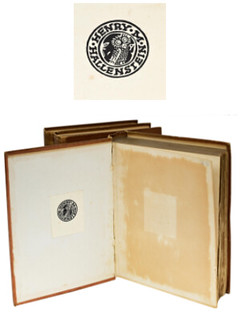
Auction 342, Lot 109: Henry Michaelis Hallenstein’s ex-libris stuck in the catalogue of Greek coins of the Hunter Collection / Glasgow. Glasgow (1899-1905). Estimate: 750 euros
The fact that Henry Michaelis Hallenstein (1872-1922) collected Greek coin is not only shown by the book in which his bookplate was stuck, but also by the depiction itself. The Athenian owl speaks for itself. Hallenstein possessed sufficient means to afford this field of collection, which was already very expensive in his time. At the end of the 19th century, his family, which originally came from Germany, was one of the most important dynasties influencing New Zealand’s economy.
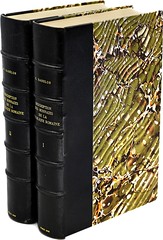

Auction 342, Lot 190: Charles M. Johnson’s bookplate stuck in Babelon’s work on the coinage of the Roman Republic. Paris / London (1885/6). Estimate: 150 euros
The bookplate of Charles M. Johnson hardly tells us anything apart from the fact that he loved books. Fortunately, George Kolbe explains in his work Reminiscences of a Numismatic Bookseller how Johnson’s library returned to the market.
In 1979, George Kolbe went to Long Beach in order to make an offer for the library of coin collector Charles Johnson. The library was huge and the collector had built a separate extension for it. George Kolbe made some calculations and presented the offer, which was immediately accepted by the collector. Unfortunately, the sale did not take place. Charles Johnson died that very day before any contracts were signed. His family sold all books on ancient and European numismatics to Douglas Saville at Spink. George Kolbe was left with the books on American numismatics. But, as he wrote himself: “Charles Johnson’s son in real life was proprietor of a used car emporium. I was no match for him.” In the end, George Kolbe paid much more than the books were worth at the time of sale. And yet he was lucky. He purchased the books at the exact time when the price of numismatic literature started to go through the roof.
Books are an investment, just like coins. The value of a numismatic library is similar to that of a share. It can rise, and it can fall. But regardless of its current material value, every library is not only a tool but also a means of reassurance. It represents the fact that numismatics is part of a centuries-old tradition. There were generations of coin collectors and numismatists before us. And there will be generations of coin collectors and numismatists after us.
No matter whether we purchase a book or a coin, it is nothing but a loan that we guard during our lifetime on behalf of the large community of collectors and that we will eventually pass on.
To read the complete article, see:
Numismatic Bookplates – a Wonderful Field of Collection
(https://www.kuenker.de/en/information/presseinformationen/aktuelle-mitteilungen/332)
To read the earlier E-Sylum article, see:
KÜNKER OFFERS POINSIGNON NUMISMATIC LIBRARY
(https://www.coinbooks.org/v23/esylum_v23n39a03.html)
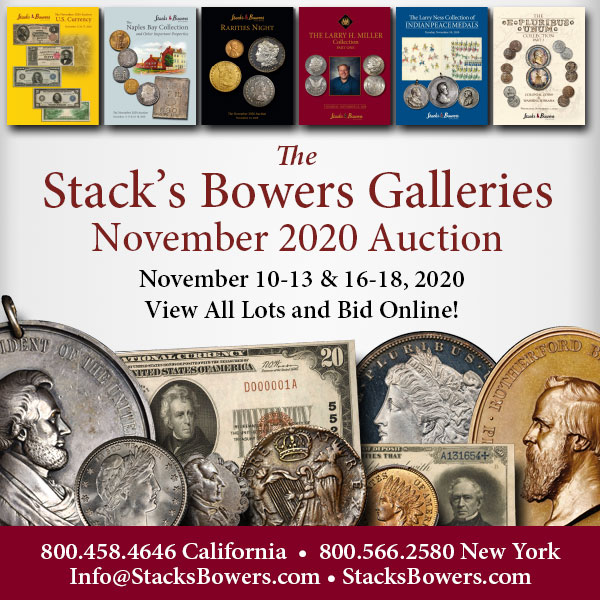
RARE BOOKS & FINE ARTS E-AUCTION 7 ANNOUNCED
Dr. Riccardo Paolucci of numismatic booksellers Rare Books & Fine Arts Ltd of London announced their new online auction closing December 6, 2020. Here are some selections. -Editor


Lots 9 and 10
Lot 9: Archivio di Stato di Firenze
Mediceo. Archivio di Stato di Firenze, 2015. Collezione di monete greche, romane e bizantine con contromarca medicea nel Museo Archeologico Nazionale di Firenze. Brossura editoriale, 364pp., 252 monete elencate + 21 da aste pubbliche. NUOVO
To read the complete lot description, see:
Lot 9
(https://www.biddr.com/auctions/rarebooksandfinearts/browse?a=1386&l=1481705)
Lot 10: History of Currency in the state of Bahrain
AA.VV. History of Currency in the state of Bahrain. Tela ed. Con sovraccoperta, pp. 174, ill. A colori. Nuovo
To read the complete lot description, see:
Lot 10
(https://www.biddr.com/auctions/rarebooksandfinearts/browse?a=1386&l=1481706)
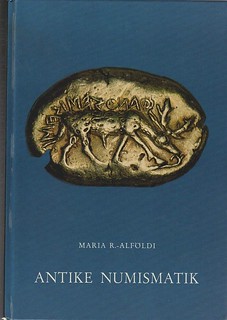
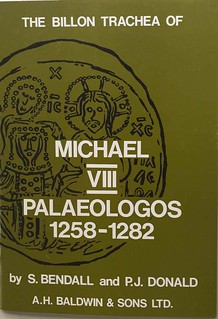
Lots 14 and 31
Lot 14: Antike Numismatik Teil I
ALFOLDI Maria R. Antike Numismatik Teil I: Theorie und Praxis. Mainz am Rhein, 1978 Cartonato, pp. xlv, 218, ill. 6 maps
To read the complete lot description, see:
Lot 14
(https://www.biddr.com/auctions/rarebooksandfinearts/browse?a=1386&l=1481710)
Lot 31: The Billon Trachea of Michael VIII
BENDALL S. & DONALD P.J.., The Billon Trachea of Michael VIII Palaeologos 1258-1282. A.H. Baldwin & Sons, 1974. Brossura ed., pp. 47., ill. in b/n . Nuovo
To read the complete lot description, see:
Lot 31
(https://www.biddr.com/auctions/rarebooksandfinearts/browse?a=1386&l=1481727)
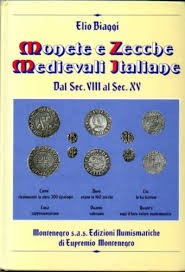
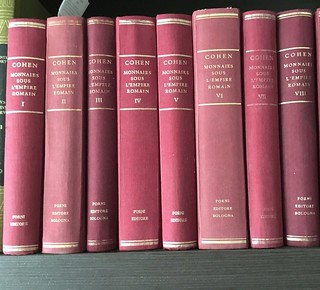
Lots 40 and 83
Lot 40: Monete e Zecche medievali e moderne
BIAGGI Elio. Monete e Zecche medievali e moderne. Torino, 1992 Hardcover, pp. 526, ill. RARE
To read the complete lot description, see:
Lot 40
(https://www.biddr.com/auctions/rarebooksandfinearts/browse?a=1386&l=1481736)
Lot 83: Cohen Roman Empire
COHEN Henry. Description historique des monnaies frappées sous l'Empire Romain communément appelées médailles impériales. Deuxième Édition. Complete series of 8 volumes Arnaldo Forni Editore, Bologna, 1970. In-8, editorial canvas. Reprint of the Paris edition, 1880-1892
To read the complete lot description, see:
Lot 83
(https://www.biddr.com/auctions/rarebooksandfinearts/browse?a=1386&l=1481779)
Lot 99: Biographical Dictionary of Medallists
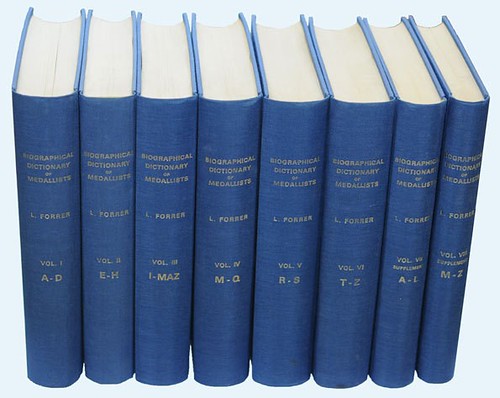
FORRER L. Biographical Dictionary of Medallists. 1923. Reprint. Vol I : xlviii + 691 pp. ; vol II : vi + 588 pp. ; vol III : 649 pp. ; vol iv : 725 pp. ; vol V : 738 pp. ; vol VI : 738 pp. ; vol VII : 567 pp. ; vol VIII : 461 pp.. 8 full canvas bound volumes. An exceptional documentation which makes this work indispensable for all those interested in medals.
To read the complete lot description, see:
Lot 99
(https://www.biddr.com/auctions/rarebooksandfinearts/browse?a=1386&l=1481795)
Lot 221: Istituzione antiquario-numismatica

ZACCARIA Francesco Antonio. Istituzione antiquario-numismatica o sia introduzione allo studio delle antiche medaglie in due libri proposta. In Roma, Monaldini, 1772. Very rare Contemporary parchment, piece with title and friezes in gold. Two parts in a volume in 16mo; pp. XXXII, 487. RARE Vignette on the title page, however with black and red characters. Headboards, letterheads and figured finalets. Finally 3 explanatory tables engraved in copper with medals. Second edition
To read the complete lot description, see:
Lot 221
(https://www.biddr.com/auctions/rarebooksandfinearts/browse?a=1386&l=1481917)
For more information, or to bid, see:
E-Auction 7 Ancient Coins, Numismatic Literature
(https://www.biddr.com/auctions/rarebooksandfinearts/browse?a=1386)
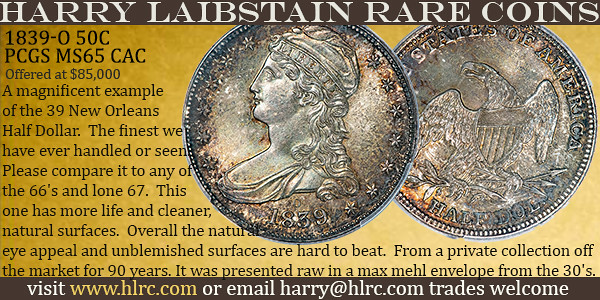
REINER SEUPEL ISLAMIC NUMISMATIC LITERATURE LOTS

These arrived too late for last week's issue. Here are some images of Islamic numismatic literature lots in the upcoming sale of the collection of Reiner Seupel. -Editor
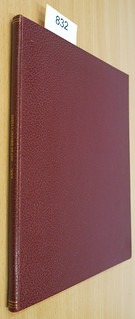

Lots 832 and 873
Lot 832. Monographs Islamische Numismatik Arri, GA Novas observationes in quosdam numos Abbasidarum aliosque Cuficos sive editos sive anecdotos nec non in duo specula et generatim in vitra literis cuficis aucta, Turin 1835, 55 p., 3 pl. In a more recent imitation leather binding rare II plates slightly foxed.
Lot 873. Monographs Islamische Numismatik Krehl, L. De Numis Muhammadanis in Numophylacio Regio Dresdensi Asservatis Commentatio, Leipzig 1856, vii, 113 S. Halbleder Extremely rare I.
To read the earlier E-Sylum article, see:
REINER SEUPEL ISLAMIC NUMISMATIC LITERATURE SALE
(https://www.coinbooks.org/v23/esylum_v23n42a04.html)
NEW BOOK: STANDARD CATALOG OF ECUADORIAN COINS
A new edition of of the Standard Catalog of Ecuadorian Coins by Dale Seppa and Michael J. Anderson is scheduled for release in January. Here's the prepublication announcement. -Editor
 Standard Catalog of
ECUADORIAN
COINS
Standard Catalog of
ECUADORIAN
COINS
A Checklist and Compendium
By Dale Seppa and Michael J. Anderson. Heavy card covers 4.5” (115 mm) by 8.5” (215 mm), 136 pages. Many items are priced generally based on recent auction results. The book is extensively illustrated with high quality drawings and photos.
Scheduled for official release January 1st, 2021. If books are ready before then they will be shipped as soon as they are available.
The book is divided into over a dozen sections to include: PRE-COLUMBIAN MONEY, COLONIAL COINAGE, WARS OF INDEPENDENCE, REPUBLICAN PROTO-COINAGE, PRE- DECIMAL COINAGE, DECIMAL COINAGE, PRE-DECIMAL GOLD COINAGE, DECIMAL GOLD COINAGE, EARLY PATTERNS & UNUSUAL, DECIMAL PATTERNS & UNUSUAL, SETS, SILVER SPECIAL ISSUES, GOLD SPECIAL ISSUES
The prepublication price for all orders received prior to January 1st of 2021 is US $40.00, postpaid to addresses in the United States. The price for orders received after January 1st is $50.00 postpaid to addresses in the United States. Foreign orders must add $10.00 for postage. Registration for foreign orders is an additional $15.00 if desired. Really I don’t remember a book being lost in the mail.
Order from Dale Seppa, 103 N 6th Ave., Virginia, MN 55792, USA. Personal Checks, Money Orders, Cash (at sender’s risk) or PayPal are accepted. Personal checks will not be deposited until books are ready for shipment. Credit card orders can be processed through PayPal. PayPal orders can be placed by sending the exact amount to daleseppa@gmail.com or by requesting a PayPal invoice from that same email address.
Dale kindly sent me a review copy from the first batch back from the printer, and it looks great. It's sturdy and a convenient size for keeping handy while perusing world coin stocks online or at shows (remember those)?
The photos are black and white but many illustrations are well-executed drawings which seem very useful. I enjoyed the sections on pattern & unusual coinage which are especially useful for recognizing rare items.
The current pricing information is what will draw the interest of active collectors. I haven't collected world coins since my younger days, but handy catalogs like this could have turned me into an active seeker for life. -Editor
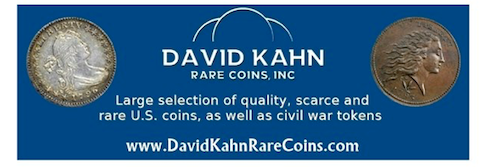
NEW BOOK: COINAGE IN EARLY ENGLISH LITERATURE
This one, published in 2011, is only new to me, but I came across it while looking for other things this week and thought I'd mention it because of the topic area: coins in literature. It's been a while since we've discussed the topic, but it's an interesting sideline. -Editor
 Coinage and State Formation in Early Modern English Literature
Coinage and State Formation in Early Modern English Literature
(Early Modern Cultural Studies 1500–1700)
by S. Deng
A reassessment of the historic relation between money and the state through the lens of early modern English literature, Coinage and State Formation examines the political implications of the monetary form in light of material and visual properties of coins as well as the persistence of both intrinsic and extrinsic theories of value.
Editorial Reviews
"A pertinent and timely intervention in the debate concerning the nature of money in Renaissance England. Through an impressively broad array of literary and cultural readings, Deng clearly establishes the vital role money played in the process of state formation. His insights into the relation between coinage and idolatry, tyranny, and the ethics of representation have obvious repercussions for our own age, and make this book important to anyone concerned about the current state of capitalism. This book is sure to remain influential on literary and economic studies for many years to come." - David Hawkes, Professor of English, Arizona State University
"Deng s book offers a detailed and fresh reappraisal of early modern coinage - what both Shakespeare and Marx call the visible god - as the turnstile through which radically opposed concepts of matter and spirit, economics and religion, and intrinsic and extrinsic value endlessly circulate. Deng s singular contribution is to show how this circulation subtends modern formations of nationhood and sovereignty." - Jonathan Gil Harris, Professor and Director of Graduate Studies Department of English, George Washington University
Print Length : 285 pages
Publisher : Palgrave Macmillan; 2011th Edition (April 11, 2011)
Language: : English
Print ISBN : 978-1-349-29261-5
Publication Date : April 11, 2011
For more information, or to order, see:
Coinage and State Formation in Early Modern English Literature
(https://link.springer.com/book/10.1057/9780230118249)
Coinage and State Formation in Early Modern English Literature (Early Modern Cultural Studies 1500–1700)
(https://www.amazon.com/Coinage-Formation-Literature-Cultural-1500-1700-ebook/dp/B009AWFYHS)

NEW BOOK: PAPER MONEY OF RHEINHESSEN 1793-1948
An article by Hans-Ludwig Grabowski on Geldscheine-Online reviews a new book by Hugo Schneider on the paper money of the Rheinhessen (wine region) of Germany. Found via News & Notes from the Society of Paper Money Collectors (Volume VI, Number 18, October 20, 2020). Here's a Google-translated version. -Editor
 Hugo Schneider:
Hugo Schneider:
The paper money of the Rheinhessen region 1793-1948
Special catalog of city, district, company and private editions
202 pages, color illustrations throughout, format 21 cm x 29.7 cm,
hardcover, Walluf 2020.
without ISBN. Price: 30 euros
Once again we can present one of these important regional works of committed emergency money collectors who wrote a special catalog for their collecting area and published it on their own. Commercial success, for example with the author of this catalog, usually does not play a role. Rather, it is about the most complete documentation possible of all paper money issues and their variants from a certain region and thus the culmination of a collector's life. The author succeeded in doing this in a particularly exemplary manner with this catalog for Rheinhessen, which was separated from Hesse by the French occupation as far as the Rhine after the Second World War and is now part of the state of Rhineland-Palatinate. Not only the detailed cataloging of variants, samples etc. should be emphasized,
In addition to the emergency money of the 20th century, you can of course also find the French siege money for the Mainz fortress from 1793 and the expenses of the Franco-Belgian railway administration for the occupied Rhineland from 1923 in the catalog.
It is to be hoped that there would soon be a similar catalog for all of Hesse. Catalogs, as we know, enliven collecting itself. Unfortunately, where there is no literature, little is collected because there is no guide.
Hugo Schneider has succeeded in creating such a guide with his book, which only appeared in a very small edition. It is nice that he was supported by other collectors, which unfortunately is not always a given.
To read the complete article, see:
Katalog zum Papiergeld von Rheinhessen
(https://www.geldscheine-online.com/post/katalog-zum-papiergeld-von-rheinhessen)

BANKNOTE BOOK PERU CHAPTER PUBLISHED
Owen Linzmayer publishes The Banknote Book, a useful, constantly updated electronic reference. The chapter on the banknotes of Peru is now available for $9.99. -Editor
 Today we are proud to present another large chapter completing coverage of yet another currently issuing country. Fewer than a handful remain, and we're working diligently to publish them as soon as possible.
Today we are proud to present another large chapter completing coverage of yet another currently issuing country. Fewer than a handful remain, and we're working diligently to publish them as soon as possible.
Peru (South America)
This 76-page catalog covers notes issued by the Junta Administradora (Administrative Board) from 1879 to 1881, the Junta de Vigilancia (Supervisory Board) from 1914 to 1918, the Banco de Reserva del Perú (Reserve Bank of Peru) from 1922 to 1926, and the Banco de Reserva del Perú became the Banco Central de Reserva del Perú (Central Reserve Bank of Peru) from 1922 to present.
Currently 293 chapters of The Banknote Book have been published as individual high-resolution PDF files. This represents a total of 7,077 pages covering 67,258 types and varieties.
For more information, or to order, see:
Peru chapter of The Banknote Book is now available
(https://banknotenews.com/?p=31187)
RESEARCH & PUBLISH A NUMISMATIC BOOK
Want to write your own numismatic book? Check out the upcoming free seminar from the American Numismatic Association and learn directly from two recent authors. -Editor

You can Research & Publish a Numismatic Book
This virtual presentation will cover what decisions the instructors had to make (and how they chose to implement them) for two different numismatic publications. The first publication included all numismatic collectibles for Chattanooga, Tennessee. The second publication included all obsolete paper money from the state of Tennessee.
Learn about the instructor's paths to publishing these two books, why they used different platforms, what kind of research was involved and what they learned from their experiences.
INSTRUCTORS: Dennis Schafluetzel and Tom Carson
DATE/TIME: Dec. 10 | 1 p.m. to 2 p.m. MST
LOCATION: Online
COST: Free!
For more information, or to register, see:
https://info.money.org/elearning/
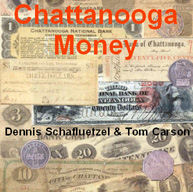

To read the earlier E-Sylum articles, see:
NEW CD BOOK: CHATTANOOGA MONEY BY DENNIS SCHAFLUETZEL
(https://www.coinbooks.org/esylum_v13n05a05.html)
NEW BOOK: TENNESSEE OBSOLETE PAPER MONEY
(https://www.coinbooks.org/v22/esylum_v22n30a05.html)
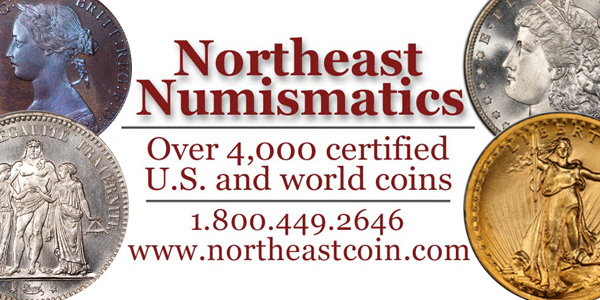
1893 ASSAY MEDAL LETTER ON NEWMAN PORTAL
Newman Numismatic Portal Project Coordinator Len Augsburger provided the following report. Thanks. -Editor
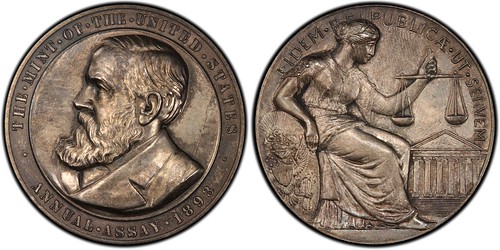
Friends in High Places
While the National Archives remains inaccessible to researchers, Newman Portal continues creating transcriptions of previously scanned material. Recently processed is an 1893 letter from the Superintendent of the U.S. Assay Office in New York City, Andrew Mason, requesting that Philadelphia Mint Superintendent Oliver C. Bosbyshell supply a medal of the Assay Commission for that year. The “ask” was made on behalf of collector Harlan P. Smith of New York City, whose cabinet was featured by the Chapman’s in a 1906 sale.
The Assay Commission medals were struck in low quantities (not all mintages are recorded, but 40-50 pieces is typical) and do not appear on U.S. Mint fixed price lists of the era. Did Smith get his medal? Quite likely so. His 1906 auction sale catalog included an extensive run of Assay Commission medals, including an 1893 silver example (lot 1664, AC-37) housed in a “morocco case.” Smith’s Assay Commission medals turned out to be a tough sell, with the Chapman’s buying-in most of the pieces, including the 1893 example at $2.60.
Image: 1893 Assay Commission medal (AC-37), dies by George Morgan. Images courtesy of PCGS.
Link to U.S. Mint General Correspondence on Newman Portal:
https://nnp.wustl.edu/library/archivedetail/515202
Link to Chapman auction sale catalogs on Newman Portal
https://nnp.wustl.edu/library/auctioncompanydetail/21
Link to U.S. Mint fixed price lists on Newman Portal:
https://nnp.wustl.edu/library/publisherdetail/512757
VIDEO: THE LIFE OF ADAM BREWER
These are selections from the David Lisot Video Library that feature news and personalities from the world of coin collecting. David has been attending coin conventions since 1972 and began videotaping in 1985. The Newman Numismatic Portal now lists all David’s videos on their website at:
https://nnp.wustl.edu/library/multimediadetail/522852
Here's one on the life of Adam Brewer. -Editor

Numismatic Tribute for the Life of Adam Brewer. VIDEO: 6:19.
Glenna Brewer, Denver Gold & Silver Exchange, David Lisot, Producer, CoinTelevision.com.
David Lisot shares with Glenna Brewer about the passing of her youngest son, Adam Brewer. Although just 20 years old, Adam had a passion for coin collecting and the business of numismatics.
An excerpt of the video is available for viewing on the Coin Television YouTube Channel at:
https://youtu.be/p-rE0gkDMws

NOTES FROM E-SYLUM READERS: OCTOBER 25, 2020
More on Plasters and Cameos
Tony Terranova writes:
"Amazing how revered Washington and Franklin were, in many mediums including Carved shell, ivory, etc. etc., from crude to very fine workmanship. It’s fun to try to see how many one can assemble."

Thanks for the image. Great pieces. -Editor
To read the earlier E-Sylum article, see:
DASSIER'S KINGS AND QUEENS OF ENGLAND MEDALS
(https://www.coinbooks.org/v23/esylum_v23n42a14.html)
Query: The Cohen Mint
Stephen Olson of Kalamazoo, Michigan writes:
"I would love to see anything your readers can dig up on Eilat Cohen & his Cohen Mint, 2004-2009, located in Brooklyn, NY (really fascinating how he learned how to mint Rhodium). While working on that, he produced some 1g gold pieces & copper "bricks." Shortly after reaching his goal in 2009, he died, but there the story ends, as far as I know. Try as I can, I can't learn anymore, but you probably know far more?"
Last week's article by Dick Johnson on Private Mints didn't mention the Cohen Mint. Can anyone help? -Editor
Stephen adds:
 "I only became familiar with the Cohen Mint from Sean Wells of the Rare World Metals Mint. Sean actually spoke to Eilat Cohen on the phone back in 2009 at which time he ordered a number of Mr. Cohen's 1g Rhodium tokens. Cohen was the first to perfect a process for minting Rhodium, but it took him 5 years to do so. In the meantime, he produced copper ingots/bricks & 1g gold tokens. Shortly after achieving his goal & producing a number of the Rhodium pieces in 2009, Cohen died. I've found photos of his mint in Brooklyn & it looks somewhat like a cement bunker!"
"I only became familiar with the Cohen Mint from Sean Wells of the Rare World Metals Mint. Sean actually spoke to Eilat Cohen on the phone back in 2009 at which time he ordered a number of Mr. Cohen's 1g Rhodium tokens. Cohen was the first to perfect a process for minting Rhodium, but it took him 5 years to do so. In the meantime, he produced copper ingots/bricks & 1g gold tokens. Shortly after achieving his goal & producing a number of the Rhodium pieces in 2009, Cohen died. I've found photos of his mint in Brooklyn & it looks somewhat like a cement bunker!"

To visit the Rare World Metals Mint website, see:
https://www.rwmmint.com/
To read the earlier E-Sylum article, see:
VOCABULARY TERM: PRIVATE MINT
(https://www.coinbooks.org/v23/esylum_v23n42a18.html)
Private Mints in China
Ted Puls writes:
"I smiled when reading the bit on "private" mints. My interest in Chinese collecting has a different twist or meaning to this term. Regarding China "private mint" is a very polite way of saying "counterfeiter". Despite the illegal (and sometimes not quite illegal) minting, the fake Cash coins were used freely in commerce. They were made in, often far away mints. Far away from the Chinese perspective ie. along the "Silk Road" in the north, and in the south: Yunnan / Annam area. These apparently were preceded by an international trade "Maritime Silk Road" coinage made in Annam, Japan, and Indonesia mimicking the Chinese coinage. These "private" mints were productive and the coinage was diverse in the variations on the original Chinese coinage. "Private mints" also copied the Japanese and Korean coinage, but less often."
To read the earlier E-Sylum article, see:
VOCABULARY TERM: PRIVATE MINT
(https://www.coinbooks.org/v23/esylum_v23n42a18.html)
Fake ISIS Coins
Leon Benett writes:
"I saw your articles on the ISIS coins. Some are still up on eBay, but I think they're fake and from China based on their availability in a significant quantity on the Chinese website AliExpress."

Yes, as suspected earlier I think these (labeled as "souvenir" on AliExpress) were fabricated based on the ISIS group's description of their planned coinage. Other coins extracted later from Syria are likely real. -Editor
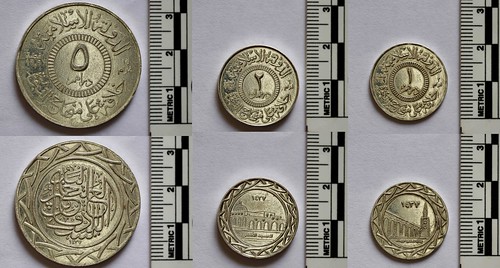
To read the earlier E-Sylum article, see:
NEW IMAGES OF ISIS COINAGE
(https://www.coinbooks.org/v21/esylum_v21n05a24.html)
Query: Hajj Token Information Sought
Jim Duncan of New Zealand writes:
"Here's one for the experts ! I already have a Hajj "dinar" token similar to some sold at St James London 2016. The piece here reminds me of it, so I wonder if anyone can hazard a guess as to origin. It's brass, 45mm, and may be cast - the people side is much clearer than the other, which is full of unexplained imagery."
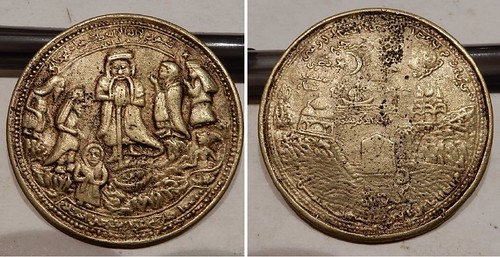
Interesting. I've never seen these. Can anyone help? -Editor
1970s Penny Shortage Treasury Special Citation Certificate
George Cuhaj writes:
"Here is a certificate I earned in the penny shortage days of the early 1970s. I took about 30 dollars of cents to the NY Federal Reserve Branch in Lower Manhattan, got escorted to their lower cash room, and got the coins counted and filled out a form. A few weeks later the offset printed certificate arrived in the mails."

Thanks. Neat item of numismatic ephemera! I wasn't aware of these. Must be a very rare item today. Would any of our other readers happen to have one? -Editor
George adds:
"Simon served starting in May 1974-77, and that overlapped with Mary Brooks who served longer. The New York Times has several cent shortage articles starting in Spring 1974 thru the summer. So I am thinking this is from that earlier date."
More on Tender, the Edge-Lettered Cent Art Project
Paul Bosco passed along a link to a news video about the New York City art project discussed in an earlier issue. Thanks! -Editor
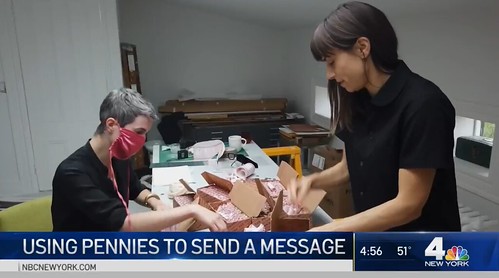
"I hope that they circulate for a very long time. Pennies circulate for like 40 years generally, so they become a kind of mark of this moment." — Brooklyn artist Jill Magid, who had 120,000 brand new 2020 pennies engraved with the words, "The body was already so fragile." She’s distributing the pennies as a “dispersed monument,” composed of small pieces that spread."
To read the complete article, see:
How Pennies Are Being Used as Brooklyn Artist's ‘Dispersed Monument' of COVID Pandemic
(https://www.nbcnewyork.com/news/coronavirus/how-pennies-are-being-used-as-brooklyn-artists-dispersed-monument-of-covid-pandemic/2674397/)
To read the earlier E-Sylum article, see:
TENDER: AN EDGE-LETTERED CENT ART PROJECT
(https://www.coinbooks.org/v23/esylum_v23n40a24.html)
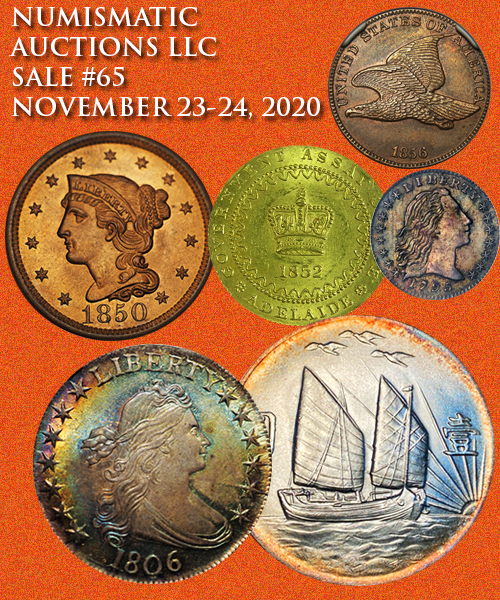
BANK OF ENGLAND MUSEUM AUDIO HIGHLIGHTS
In his October 18, 2020 Blind Coin Collector blog post, Tom Babinszki wrote about a new online initiative at the Bank of England museum. With permission, we're republishing it here. Thanks, Tom. -Editor
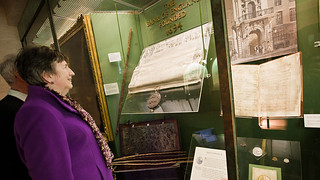 The Bank of England started an interesting initiative, describing their collection. As they claim on their site, it is suitable for visually impaired adults. There is no information about the initiative, but it speaks for itself.
The Bank of England started an interesting initiative, describing their collection. As they claim on their site, it is suitable for visually impaired adults. There is no information about the initiative, but it speaks for itself.
Often times, the problem with describing artifacts for blind people is that there is a small target audience at a high expense of description. Not to mention that many blind people don’t consider numismatics as a viable hobby, thus, making numismatic objects accessible in any way may not draw a big audience.
But the Bank of England put a twist on this project. Instead of describing the objects to blind people, they created an overview which can be interesting for all, but it does not exclude blind people.
So far there are two descriptions, a gold bar, and a sculpture of Britannia.
They are described by Dr. Miranda Garrett, the Museum’s Collection and Exhibitions Manager. She does not only describe the objects, but puts them into perspective and tells us about their story. We learn about the history of the gold bars, measurements, how Britannia was displayed on coins and currency, or we learn why she is carrying an olive branch. Each video is about 6 minutes long, and the majority of the presentation is targeted to all people. But here is the twist: part of the presentation describes what can be seen to make it enjoyable to those who can’t see the visuals. This is by no means disturbing or overwhelming for those who can see the video, but this way, they did not create a product at a high expense for a small audience. Rather, they made their products inclusive which most people can enjoy, including those who can’t see, or can’t hear for that matter, because the videos are also transcribed.
The solution is simple and elegant, yet so rarely used. If the video would assume that people are able to see it, it would only convey parts of the information for blind people, who would still benefit from it, but would lose probably the most important aspects. Yet, with a little consideration and some extra work, it is enjoyable by all.
I have to admit, I was not familiar with this site before, so I started browsing around and found that they have a highlight of their collection, which is very nicely done. Even without understanding the images, the descriptions are interesting, and the site is very usable with a screen reader.
I truly appreciate the work you had done, it is such a rare gem for a blind numismatist, and so useful for any interested visually or hearing impaired people. I would like to encourage you to continue this unique inclusive collection.
For highlights of the Bank of England collection, see:
Highlights from our collection
(https://www.bankofengland.co.uk/museum/online-collections)
To listen to audio descriptions of objects, see:
Audio described highlights from our collection
(https://www.bankofengland.co.uk/museum/whats-on/2020/audio-described-highlights-from-our-collection)
To read the complete article, see:
The Bank of England describes their collection for visually impaired people
(https://blindcoincollector.com/2020/10/18/the-bank-of-england-describes-their-collection-for-visually-impaired-people/)
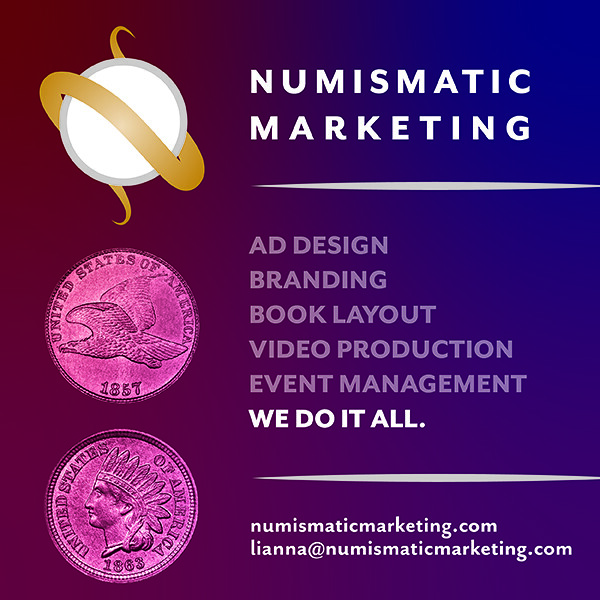
STONE MOUNTAIN DISTINGUISHED SERVICE MEDAL
New subscriber Ty Gardner has questions for our readers about the 1926 Stone Mountain Distinguished Service Medal. Can anyone help? -Editor
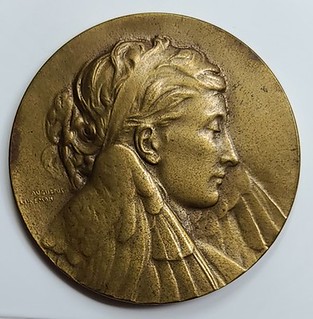
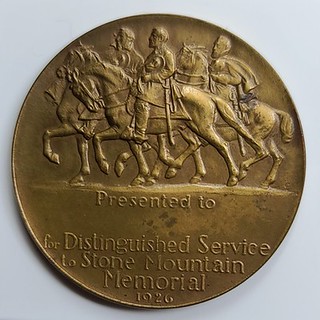
Here is an image of my 1926 Stone Mountain Distinguished Service Medal. The diameter is 40mm, Bronze and the edge is stamped Medallic Art Co NY. Designed by Augustus Lukeman.
It is my understanding that 29 medals were struck in gold and given to the 29 girls that sold the most Stone Mountain half dollars during the Harvest Campaign. A loop was added to the top and their names were engraved on the reverse.
These medals were featured in the May 1927 edition of The Numismatist magazine.

I have a few questions,
First, were these 29 Medals actually struck in gold or were they gold plated?
 My second question, which pertains to my piece and is my primary focus in researching this medal, is whether or not any other Bronze examples were struck. In speaking with David Hill, Librarian at the ANS, he does not have any record of this medal actually being ordered in Bronze, but he was able to provide me with the specs for the proposed medal.
My second question, which pertains to my piece and is my primary focus in researching this medal, is whether or not any other Bronze examples were struck. In speaking with David Hill, Librarian at the ANS, he does not have any record of this medal actually being ordered in Bronze, but he was able to provide me with the specs for the proposed medal.
Also, I haven’t been able to find any other examples of this medal in Bronze in any auction archives. I would love to know if anyone else knows of other examples, or has any history on the piece.
My initial thoughts are that my piece may be some sort of prototype.
Because it is Bronze and the documented examples, which were given to the 29 young ladies, were gold, and the fact that the cartouche of my example is not engraved, I am wondering if maybe this was simply a prototype which was cast as an example for the Stone Mountain Confederate Monumental Association for their review and approval?
These are simply my thoughts, as I have not been able to find any other examples or documentation relevant to my medal.
Here is a better image of the medal in the ANS collection; this was sent to me by David Hill:
http://numismatics.org/collection/1940.100.2071

VOCABULARY TERM: HEAT TREATING
Dick Johnson submitted this entry from his Encyclopedia of Coin and Medal Terminology. Thanks. -Editor
Heat Treating. The controlled heating and cooling of metal to change its physical properties; it includes annealing, quenching and tempering, among others. Each metal has the characteristic that its properties are changed with the raising and lowering of temperature, often rapidly. Iron or steel is important in coin and medal manufacture – primarily for dies – and steel can be heat treated to extremes of hardness, for example, soft for cutting in the design, hard for striking. Art medals with high relief design can only exist because of heat treating: the metal composition – traditionally bronze or silver – can be softened by annealing after each strike, allowing for another blow to build up the high relief.
Here are some of the specific areas in which heat treating is used in coin and medal making:
Annealing is the heat treating process to soften metal; it also improves the grain structure and by so doing it relieves any stress in the metal. Each step of metalworking – particularly striking – work hardens or creates stress in the metal. (Subsequent striking is futile, moving any more surface metal as in striking becomes nearly impossible.) Annealing relieves this stress and makes the surface softer after which the medals are receptive and can be given an additional blow or other metalworking activity.
The metal to be annealed is heated in a furnace. Time and temperature are important! For medals the stress hardening is not that deep in the metal so the annealing must be for the surface only (requiring less time at high temperature). The metal is then cooled, ultimately to room temperature. Annealing can be done in a batch furnace, a continuous belt furnace, or a salt pot furnace. The cooling can be done by water or air.
Steel dies occasionally need to be softened once they had been hardened, to correct an error in the die, or for any retouching or recutting. A common act is to change the date in a die used every year.
Another term of annealing is normalizing. This is a process to return the metal to a desired state by allowing it to return to room temperature slowly.
Quenching is the rapid cooling for hardening once the object – like a steel die – is heated to above a critical temperature. The heat and rapid cooling causes the steel to harden.
The rapid cooling is accomplished by immersion in a liquid bath of oil, water, brine, liquid salt, or very infrequently, by air. Oil gives a slower cooling rate than water, brine is faster than water. Air cooling is done with a fan. Generally high carbon steels are quenched in oil, low carbon steels in water.
The die is immersed into the liquid bath, raised and lowered about 20 times, but it must remain completely submerged in the liquid, allowing the temperature to lower at a uniform rate. Should it be exposed to air, particularly early in this treatment, it may flare up; too early of an exposure would cause an uneven hardening and possibly quenching crack.
Tempering is a reheating and recooling to treat the deeper internal metal stresses. Lower temperatures are used but the time and temperature becomes more critical, thus controlling these is vital. The quenching is done with oil, water, brine or air.
Other terms of tempering is draw, drawing, slowly bringing metal to a desired temper, and normalizing, a softening and improvement of the metal grain structure.
Heat treating ovens. Modern ovens used for heat treating have very sophisticated temperature controls. Of course, this was not always the case, and early mints and medal makers had the problem, of controlling ovens in which they needed to harden dies, and soften metals for striking.
Those early ovens required operators who could "read" the temperature of the oven by the color the steel became. For example here are the colors, temperatures and some typical applications for each:
| Steel Color | Temp. | Typical Use |
|---|---|---|
| Light straw | 428° F | Engraving tools |
| Dark straw | 469° F | Hammer face |
| Orange | 491° F | Shear blades |
| Red | 509° F | Knife blades |
| Purple | 531° F | Circular saw blades |
| Bright blue | 550° F | Axe blades |
| Dark blue | 600° F | Hacksaw blades |
| Faint red | 878° F | |
| Dull blood red | 990° F | |
| Full blood red | 1050° F | |
| Dull cherry red | 1195° F | |
| Full cherry red | 1375° F | |
| Light cherry red | 1550° F | |
| Deep orange | 1640° F | |
| Light orange | 1730° F | |
| Yellow | 1832° F | |
| Light yellow | 1976° F | |
| White | 2200° F | |
| Bright white | 2550° F | |
| Dazzling white | 2730° F |
In all heat treating processes the hardness is tested often with hardness testers either Rockwell or Brinnel. The instruments test the surface hardness by an indenter of a steel ball bearing or diamond point pressing against the surface. See HARDENING.
Looking for the meaning of a numismatic word, or the description of a term? Try the Newman Numismatic Portal's Numismatic Dictionary at: https://nnp.wustl.edu/library/dictionary
Or if you would like a printed copy of the complete Encyclopedia, it is available. There are 1,854 terms, on 678 pages, in The Encyclopedia of Coin and Medal Technology. Even running two a week would require more than 19 years to publish them all. If you would like an advance draft of this vital reference work it may be obtained from the author for your check of $50 sent postpaid. Dick Johnson, 139 Thompson Drive, Torrington, CT 06790.
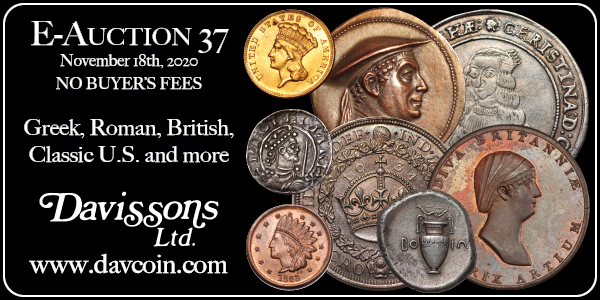
JOHN WHITE HASELTINE (1838-1925)
John Lupia submitted the following information from the online draft of his book of numismatic biographies for this week's installment of his series. Thanks! As always, this is an excerpt with the full article and bibliography available online. This week's subject is Philadelphia coin dealer John W. Haseltine. -Editor
 Haseltine, Captain John White (1838-1925), Philadelphia coin dealer. Captain in the Civil War. Afterwards a clerk at Haddock & Reed, Co., 164-166 Market Street, Philadelphia, Pennsylvania, where he worked in his family business, formerly called Haseltine, Haddock, Reed & Co. The firm of Haddock & Reed, Co., was dissolved in 1871.
Haseltine, Captain John White (1838-1925), Philadelphia coin dealer. Captain in the Civil War. Afterwards a clerk at Haddock & Reed, Co., 164-166 Market Street, Philadelphia, Pennsylvania, where he worked in his family business, formerly called Haseltine, Haddock, Reed & Co. The firm of Haddock & Reed, Co., was dissolved in 1871.
He was born on September 6, 1838, the son of John Haseltine (1793-1871), a native of Massachusetts and a very wealthy and successful businessman, and his wife Elizabeth Stanley Shinn Haseltine (1811-1882), a native of Pennsylvania, and an amateur landscape painter. He was one of ten children. Elizabeth’s mother Mary Shinn lived with at the Haseltine’s home in Philadelphia and is listed as age 84 in the US Census of 1870, at the family residence 706 Spruce Street, Philadelphia. At that time the Haseltine family had three live-in domestic servants from Ireland : Ellen Gallaher (1820), Mary Donnagan (1845-), and Mary Hogan (1845-). In that same census report the Haseltine home was estimated at $80-100,000.
In 1854 he became a clerk in the book trade. He began collecting postage stamps. Later he worked in the wholesale boot and shoe industry. On August 20, 1861 he joined the Company B. Pennsylvania 2nd Calvary Regiment as 1st Lieutenant. He was promoted to full Captain on October 1, 1862 of the 2nd Pennsylvania Calvary. He was promoted to Captain in 1863. He was taken home wounded in 1864, when his horse was shot from under him at Petersburg, falling onto him in a swamp leaving him unconscious.
Renown numismatist of the 19th-20th centuries, he was a collector and a dealer of both stamps and coins. He was the treasurer of Mason & Co., mining companies located at 506 Walnut Street, Philadelphia. Haseltine was and his family were invested in mining operations in Colorado, in the Pioneer Mining Company, and the American Exploring Company.
He sold his early stamp collection for $1,000 raising funds to enter the stamp dealing business full time. It was after that sale that he became the second business partner of Ebenezer Locke Mason selling coins and stamps.
He married Rose, the daughter of William Idler, jeweler and coin dealer. He married on June 9, 1869 Rose A. Idler (1848-).
He was elected as corresponding member of the ANS 1877-1879, 1879-1881 In 1878, he published a stamp catalogue comprising 102 pages, that went into several editions.
A Captain in the Union Army during the Civil War he kept active in veteran affairs attending the annual meetings of the Grand Army of the Republic. He retained the name of Captain Haseltine into the twentieth century when B. Max Mehl in his Numismatic Monthly referred to him by this name.
He was a coin collector, dealer and stockbroker. He employed Henry Chapman and his brother Samuel Hudson as assistants in his coin trade.
Haseltine’s 1794 cents were sold in his sale on March 16-18, 1881. Others of his large cents were sold in another of his sales on November 28-30, 1881. Also , he published Haseltine’s Type Table of Silver Coins, cited in Mason's Herald, Vol. III, No. 3, December (1881).
In 1885 his coin auction sale was confiscated by the US Mint under the direction of Captain Wallace W. Hall, United States Secret Service, since it contained an 1804 silver dollar and several other coins in the sale were discovered to have been counterfeited within the year.
On February 28, 1888, Scott held the Linderman sale at Bangs & Co., New York. The government seized the pattern coins sold to him by Haseltine, who was also under investigation since 1885.
He died on February 28, 1925, at his home at 7315 Oak Avenue, [Oak Lane], Cheltenham, Pennsylvania. He was survived by his wife and daughter Mrs. Marion H. Richards of Cranford, New Jersey. His obituary is in The Numismatist, April (1925) : 225-226. Inducted into the ANA Numismatic Hall of Fame in 1974.
To read the complete article, see:
HASELTINE, JOHN WHITE
(http://www.numismaticmall.com/numismaticmall-com/haseltine-john-white)

HARVEY STACK'S NUMISMATIC FAMILY, PART 81
The latest article in Harvey Stack's blog series continues his look at auction sales of the 1980s, including the notable Frederic S. Knobloch Collection of Roman Imperial Coins. Thanks, Harvey! -Editor
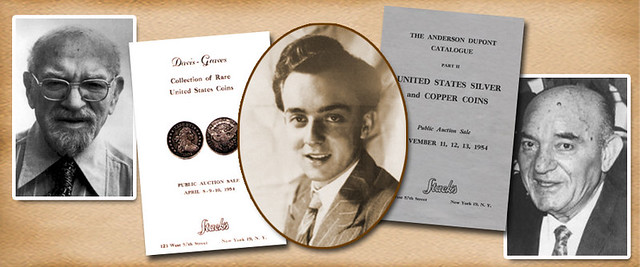
Stack's presented over half a dozen public auctions in 1980, featuring collections from various museums as well as private collectors. In February we featured items from several important places, highlighted by a comprehensive collection from the New Canaan Historical Museum. Also included was a cabinet of Charlotte Mint gold coins from Parks Dalton, who with his father and brother had assembled a major collection of this very popular specialty. There were other collections geared toward general collectors, making up a sale of over a thousand lots. Our March sale included items from the Detroit Historical Society, as well as the collection of, Dr. J. Hewitt Judd.
In May we were honored to present the Frederic S. Knobloch Collection of Roman Imperial Coins, which we sold in conjunction with the Metropolitan New York Numismatic Convention that was held at the Park Sheraton Hotel in New York. The sale featured 1,438 lots and was one of the most extensive collection of Roman Imperial Coins offered for sale in the 20th century.
Fred Knobloch was a dedicated collector of coins of the Ancient world. During the 1970s Fred had consigned collections of Ancient Greek coins, and later his collection of Roman Republic coins. Fred had worked for a major civil service agency, and thus was building a superior collections on limited funds. This is what led him to sell his Greek and Roman Republic coins, so he could concentrate on the Roman Imperial series. These Imperial coins told of the empire's history through the portraits of the Roman Imperial rulers, and the conquests of the world illustrated on most of the pieces. It was a great challenge to get the collection as complete as possible. Fred worked with our catalog team arranging and describing each coin. The Knobloch catalogs became guides for others who were pursuing these coins and are still used today as guides and reference texts. Fred was an active member of all nine numismatic clubs in the Metropolitan New York area and he would lecture on various aspects of Ancient coin collecting at these clubs and also at various museums and libraries.
The convention and the Knobloch auction attracted dealers and collectors from all over the world, and each of the sales brought wonderful prices. Even with the drop in the silver market having a negative effect on numismatics in general, the sale of this collection was very successful and brought some record prices for the time.
In June Stack's offered a sale with over 1,000 lots, mainly United States coins but also featuring 160 lots of world coins. It was a popular sale due to the wide variety of offerings. Once again, this showed the basic enthusiasm that was still in the coin hobby, and was a precursor for the market improvements that would come later in the year.
In August Stack's once again joined in partnership with three other firms to present Auction '80. The 500 lots Stack's presented in the sale included rare type coins, early Liberty Seated and Barber Proof sets, minor coins in Proof and Mint state as well as an extensive offering of silver dollars, from early years through Morgans. This time the sale was held in Cincinnati, attracted collectors from all over the nation and featured enthusiastic bidding.
Our very successful sale of the Knobloch Collection earlier in 1980 brought in further consignments of ancient and world coins and in September we offered a sale of 524 lots. While the sale was relatively small, we received a large number of mail bid sheets, phone bids, and there was a large audience of advanced collectors. The activity at the sale seemed to confirm that the interest in collecting was reviving.
In October Stack's sold the estate of Charles Kahn, a 985 lot collection of United States gold, silver and copper coins, mostly in choice and better grade. It was assembled over several decades and, again, the extent of the offering attracted a crowd of well-known and outstanding collectors to New York to participate in the sale. Though the market was not as high as a few years back, the scope and quality of the collection resulted in high prices. Stack's 1980 auction season closed out with our December sale featuring more than 850 lots of popular United States gold, silver and copper. Our December sales often were well attended, as collectors would come to the city before the holidays and participate in the auction while their wives and families would spend time shopping.
While 1980 was not an easy year to navigate, Stack's was able to have a somewhat successful season because of the number of consignments we were able to obtain and present and the fact that dedicated numismatists were still able to visit us, and buy or trade. As things had started to trend upward in the market, we looked forward to a better year in 1981.
To read the complete article, see:
Harvey Stack Remembers: Growing up in a Numismatic Family, Part 81
(https://www.stacksbowers.com/News/Pages/Blogs.aspx?ArticleID=harvey-stack-remembers-part-81)
To read the earlier E-Sylum article, see:
HARVEY STACK'S NUMISMATIC FAMILY, PART 80
(https://www.coinbooks.org/v23/esylum_v23n41a17.html)
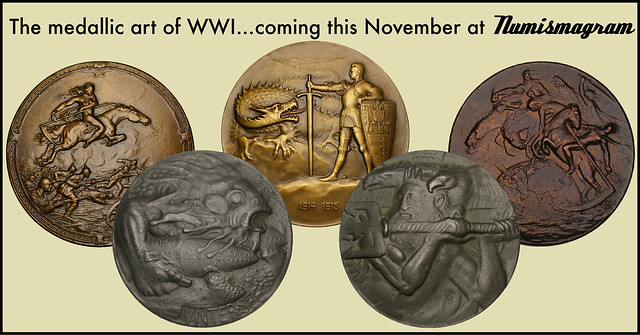

STACK’S BOWERS GALLERIES OPENS NEW YORK LOCATION
As announced earlier, Stack’s Bowers Galleries is opening their new location in New York City. Here's the press release. Looks great! -Editor
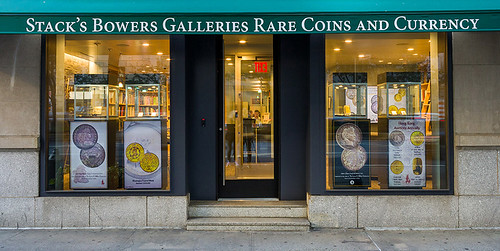
at 470 Park Avenue (Between 57 th and 58 th Streets)
Stack’s Bowers Galleries is thrilled to announce the opening of their new flagship gallery at 470 Park Avenue in Midtown Manhattan. Located just down the block from their historic West 57th Street storefront, this new gallery at 470 Park Avenue will serve as the East Coast’s premier numismatic destination for a new generation of collectors.
With modern, spacious, and secure facilities, this new gallery will offer the firm’s entire range of services covering all manner of numismatics, appraisals, gold and silver bullion and retail sales, and auction expertise. Collectors will be able to browse an extensive selection of coins and paper money available for direct purchase, as well as view upcoming auction highlights that will be on display throughout the gallery. The location also features meeting spaces for private consultations and will host public lot viewing for the firm’s auction sales, beginning with their November 2020 Showcase Auction. Located at street-level along one of New York’s most iconic avenues, the new space at 470 Park between 57th and 58th streets is now open and inviting all collectors. Appointments are recommended, though walk-in consultations will be accommodated pursuant to local COVID-19 guidelines.
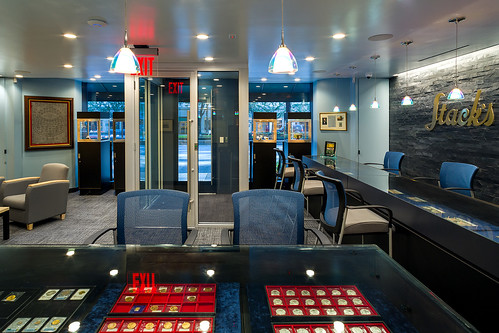
For over 85 years, Stack’s Bowers Galleries has served as the hobby’s premier resource for collectors. Established in 1933 by brothers Joseph and Morton Stack, Stack’s Rare Coins first opened for business in New York City at 690 Sixth Avenue near the Flatiron Building. Within the first decade of operations, Stack’s grew to become the nation’s leading numismatic firm, successfully navigating the depths of the Great Depression and adapting to the removal of gold as a monetary standard. This innovation and resiliency in challenging times can still be witnessed in the firm’s leadership today, most recently during the COVID-19 pandemic.
Stack’s Rare Coins held their first auction sale in 1935 and served as an official distributor of United States Mint commemoratives in 1936. Their first auction at the American Numismatic Association’s annual summer convention took place in 1939, an honor that the firm has maintained in recent decades. Stack’s moved uptown in 1939 to 32 West 46th Street and in 1953 relocated to their historic 123 West 57th Street location, where the firm would operate for the next 67 years.
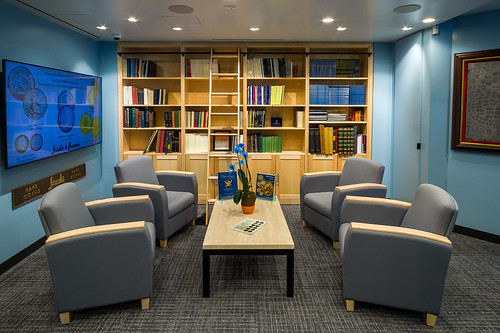
Morton’s son Harvey G. Stack joined the staff full time in 1947 and continues to guide the firm to this day, working alongside his own son, Lawrence R. Stack. The merger of Stack’s Rare Coins with American Numismatic Rarities in 2006, and then with Bowers and Merena in 2011, integrated the world’s greatest numismatic minds under one enterprise, and Stack’s Bowers Galleries is proud to offer that world-class expertise to all of its clients. The firm’s recent acquisition of Carter Numismatics in the summer of 2020 continues this trend of seeking out the industry’s foremost experts, making Stack’s Bowers Galleries an unrivaled resource for collectors across the globe.
Contact the Stack’s Bowers Galleries New York team at 800-566-2580 or NYC@StacksBowers.com to setup an appointment and experience the new gallery at 470 Park Avenue for yourself. Located just a few blocks from Central Park between E. 57th and E. 58th streets, the gallery is easily accessible by subway and bus, and convenient parking solutions are available nearby.
To read the earlier E-Sylum article, see:
STACK'S BOWERS ON THE MOVE IN NEW YORK
(https://www.coinbooks.org/v23/esylum_v23n08a19.html)

VAN RYZIN UPDATES 1913 LIBERTY NICKEL RESEARCH
In a two-part article published in Numismatic News, Bob Van Ryzin details newly uncovered information on the first showing of the 1913 Liberty Head nickel. The E-Sylum gets a shout-out as well. Here's a very short excerpt - see the complete article online. -Editor
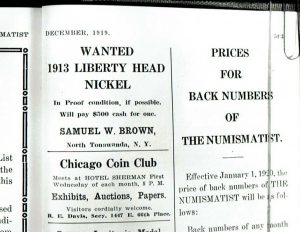 Until my article, “Shadowy rarity: 1913 nickel first seen in 1919, not 1920,” appeared in the Aug. 1, 2017, issue of Numismatic News, most who have explored the sketchy history of this coin recorded that the earliest documented showing of the nickel was at the late August 1920 ANA convention in Chicago. There were rumors that Samuel W. Brown, a former Philadelphia Mint employee, long linked by collectors to the 1913 Liberty Head nickel’s questionable creation, had exhibited the coin at a CCC meeting prior to his bringing it to the 1920 annual convention. However, documentation of such a meeting was lacking, until it was discovered within the club reports in the pages of The Numismatist.
Until my article, “Shadowy rarity: 1913 nickel first seen in 1919, not 1920,” appeared in the Aug. 1, 2017, issue of Numismatic News, most who have explored the sketchy history of this coin recorded that the earliest documented showing of the nickel was at the late August 1920 ANA convention in Chicago. There were rumors that Samuel W. Brown, a former Philadelphia Mint employee, long linked by collectors to the 1913 Liberty Head nickel’s questionable creation, had exhibited the coin at a CCC meeting prior to his bringing it to the 1920 annual convention. However, documentation of such a meeting was lacking, until it was discovered within the club reports in the pages of The Numismatist.
The 1919 CCC meeting, where the nickel was first shown (and later remembered by the “older members” in 1934), was held on Wednesday, Dec. 3, 1919.
Tucked away, rather matter-of-factly, in the secretary-treasurer’s report, just after Mr. Boyer’s gold rush $50 slugs and ahead of an “interesting exhibit” of obsolete paper money by Mr. Leon, is this reference to Samuel W. Brown’s exhibit:
“By Mr. S.W. Brown: Proof nickel of 1913, of the old type. Proof nickels are not supposed to have been struck during that year [italics added].”
Here then is the 1913 Liberty Head nickel’s first recorded appearance. The coin was shown that evening to 18 CCC members and guests. Several of these were experienced numismatists who would have recognized the nickel’s import and long remembered their first brush with this mega rarity.

Perhaps of great significance to the 1913 Liberty Head nickel’s arrival on the numismatic marketplace, and largely unobserved, was Brown’s visit to the 1919 Philadelphia ANA convention, where he took part in an American Numismatic Association-arranged tour of the Philadelphia Mint on Monday, Oct. 6, 1919. He is pictured in the official convention photo, taken on the mint steps following the tour. The image was reproduced in the November 1919 issue of The Numismatist and the December 1919 issue of Mehl’s Numismatic Monthly.
Following the nickel exhibit at the CCC meeting in December, Brown ran advertisements in the January through March 1920 issues of The Numismatist offering to buy specimens of the 1913 Liberty Head nickel, but with an increase in the price he was willing to pay to $600 per coin.
Bob places key events in probable time sequence, taking into consideration the lead time needed to submit articles and advertising to print publications, asking "Was the placement of his buy ad so soon after his Philadelphia convention/mint visit a coincidence or an outcome of it?"
He also reviews other 1913 Liberty Nickel buying ads that popped up around the country, including a mysteriously early one by teenage dealer Harry Kelso of Arma, Kansas on January 22, 1920. See the complete article online for much more. Interesting! -Editor
To read the complete articles, see:
New Light Shed on Mysterious Past of 1913 Liberty Head Nickel
(https://www.numismaticnews.net/article/new-light-shed-on-mysterious-past-of-1913-liberty-head-nickel)
Mysterious Past of 1913 Liberty Head Nickel: Part Two
(https://www.numismaticnews.net/article/mysterious-past-of-1913-liberty-head-nickel-part-two)

ANS 2020 HUNTINGTON AWARD TO SYD MARTIN
The American Numismatic Society has bestowed its 2020 Huntington Award on Numismatic Bibliomania Society Governor Syd Martin. Congratulations! Here's the press release. -Editor
 The Trustees of the American Numismatic Society (ANS) have voted to bestow upon Mr. Sydney Martin the 2020 Archer M. Huntington Award in recognition of his scholarly work specializing in Colonial American coinage.
The Trustees of the American Numismatic Society (ANS) have voted to bestow upon Mr. Sydney Martin the 2020 Archer M. Huntington Award in recognition of his scholarly work specializing in Colonial American coinage.
The award ceremony will be held on Thursday, November 19, 2020, at 1:00 pm ET at the American Numismatic Society, 75 Varick Street, in New York City and will be available to attend virtually via zoom. Featured during the event will be the Silvia Mani Hurter Memorial Lecture by Mr. Martin, entitled “Numismatic Commemoratives of the 200th Birthday of George Washington in 1932.”
Mr. Martin has written several articles on Colonial numismatics for the Colonial Newsletter, and has presented papers at the Coinage of the Americas Conference (COAC), historical societies, and clubs. In 2006 he became the editor, and is now the Associate Past Editor, of the award-winning C4 Newsletter.
Most significantly, Mr. Martin is the author of four acclaimed books in the field, all published by the Colonial Coin Collectors Club: The Hibernia Coinage of William Wood (1722–1724); The Rosa Americana Coinage of William Wood; French Coinage Specifically for Colonial America; and St. Patrick Coinage for Ireland and New Jersey. Each of Mr. Martin’s books illustrate his systematic approach to identifying and cataloging numismatic material, which he places in a much wider context focusing on economic, political and monetary developments for the era in which the series studied was struck.
In the words of Michael Hodder, The Hibernia Coinage of William Wood (1722–1724) is “one of the most thorough, authoritative, and ultimately useful numismatic studies on any subject that has been undertaken in the past century.… Syd Martin’s study organizes a previously inchoate mass of data on the coinages, adds new information, and creates what will become … the standard work on the series.”
Mr. Martin, of Doylestown, PA, earned both a bachelor’s and master’s degree from the Massachusetts Institute of Technology. He worked for a defense company until 1988 when he founded his own defense-oriented firm, Sytex, serving as president and CEO of The Sytex Group, Inc. (TSGI) until its sale to Lockheed-Martin in 2005. As part of the sale he retained control of a high-tech, defense subsidiary, Macaulay-Brown, Inc., a nationally recognized firm with 1,500 employees, which he sold to Alion Science and Technology Co. in 2018. He founded Martin Enterprises, Inc., with interests in agriculture, real estate, and finance.
Mr. Martin is a major contributor to the ANS. His generous pledge helped to kick off the Campaign to Endow the Chair of the Executive Director. In 2009 the Society’s Conference Meeting Room was named in his honor for his contributions to the ANS. He has been a member of ANS since 1997, a Life Associate since 2002, was elected as a Fellow in 2009, and is one of the founding members of the Augustus B. Sage Society. Elected to the Board of Trustees in 2005, Mr. Martin served as Treasurer from 2009–2012 and Board President since 2012.
“We are thrilled to offer this prestigious award to Mr. Martin,” said ANS Executive Director Dr. Gilles Bransbourg. “His outstanding contribution to numismatic scholarship, most notably covering fascinating and often understudied aspects of the colonial period, represent a tour-de-force of hard work, extensive knowledge, and factual accuracy. His books will remain major and vital references for generations to come”.
The Archer M. Huntington Award, first presented to Edward T. Newell in 1918, is conferred annually in honor of the late Archer M. Huntington, ANS President from 1905 to 1910, in recognition of outstanding career contributions to numismatic scholarship. The medal was designed in 1908 by Emil Fuchs to commemorate the 50th anniversary of the founding of the American Numismatic Society.
To read the complete article, see:
2020 Huntington Award to Syd Martin
(http://numismatics.org/2020-huntington-award-to-syd-martin/)

COIN WORLD'S MOST INFLUENTIAL PEOPLE SURVEY
As part of their 60th anniversary celebration, Coin World is compiling a list of the most influential people in numismatics over the past 60 years. As a U.S.-based publication the nominee list is heavily weighted toward U.S. numismatists. E-Sylum readers will see a lot of familiar names. Our readers and contributors include the cream of the crop of top researchers, authors, collectors and dealers. Cast your votes for who you think should make the final list. -Editor
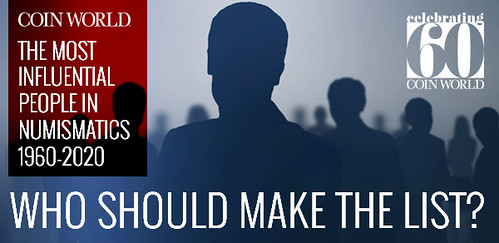
To cast your vote, see:
Coin World's Most Influential People in Numismatics from 1960-2020
(http://www.coinworld.com/influential/)
ANA'S 2021 SERVICE AWARD NOMINATIONS SOUGHT
Nominations for their 2021 service awards are now being accepted by the American Numismatic Association. Here's the press release. -Editor
Deadline for Award Nominations is Jan. 15

Each year, the American Numismatic Association (ANA) presents awards to deserving individuals in recognition of outstanding dedication to numismatics. The ANA is now accepting individual nominations for 2021 awards and Numismatic Hall of Fame "Modern Era" candidates.
All nominations can be submitted in writing and online – 300 words or more for the Numismatic Hall of Fame, and 50-100 words for all other awards. Nominations are accepted through Jan. 15, 2021.
- Numismatic Hall of Fame – "Modern Era" nominees (living individuals or individuals deceased within the last 25 years) will be considered. Candidates are not required to be present or past ANA members.
- Farran Zerbe Memorial Award – The ANA's highest honor, this award recognizes years of outstanding, dedicated service to numismatics.
- Lifetime Achievement Award – Presented to an individual, family, firm or judicial entity for contributions to organized numismatics.
- Elvira Clain-Stefanelli Memorial Award for Achievement in Numismatics – This award honors women who have made a lasting impact to numismatic community and demonstrated lifelong commitment to the betterment of numismatics, whether through research, leadership or mentorship.
- Numismatist of the Year – Recognizes individuals within the numismatic community who have demonstrated long-term leadership in the field and to the ANA.
- Harry J. Forman Dealer of the Year Award – Honors professional numismatists who exhibit uncommon dedication to strengthening the hobby and the ANA and displays exemplary ethical standards as a numismatic dealer.
- Numismatic Art Award for Excellence in Medallic Sculpture – The award honors an artist whose cumulative lifetime achievements in the field of medallic sculpture have been of the highest order.
- Adna G. Wilde Jr. Memorial Award for Exemplary Service – Awarded to an ANA member who has dedicated time and resources to strengthen the hobby and further the ANA's educational mission, setting an example for others to follow.
- Medal of Merit – Recognizes individuals who have dedicated numerous years of service to the ANA and promotion of the hobby.
- Glenn Smedley Memorial Award – This award honors individuals who have devoted their efforts to the betterment of the ANA.
- Lawrence J. Gentile, Sr. Memorial Award for Outstanding Adult Advisor – Recognizes individuals who have devoted their time and efforts to recruiting beginning young numismatists, and aiding the development of intermediate to advanced YNs.
- Young Numismatist of the Year – Honors numismatists under the age of 18 for outstanding contributions to the hobby and who are active in volunteer service and numismatic research.
- Outstanding District Representative – Recognizes the District Representative who most fully promotes coin collecting, coin clubs and the ANA.
Submit a nomination for a numismatist you find deserving of an award. Information about each of the awards and online submission forms can be found here: https://www.money.org/service-awards-categories
For questions about the awards, please contact awards@money.org or call (719) 482-9811.

HOLABIRD FALL 2020 SALE SELECTIONS
Here's a selection of lots that caught my eye in the upcoming Holabird Western Americana Collectibles sale First, here's an overview by Fred Holabird. -Editor
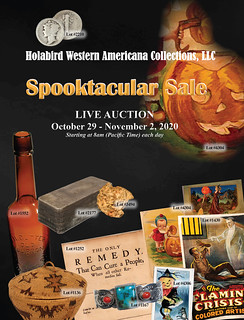 This sale features some amazing one of a kind rarities, and also brings to market several long awaited collections.
Perhaps the top item in the sale is the Pierce Powell copy of the all-time #1 “psychedelic” rock n roll poster, the Charlatans at the Red Dog Saloon, Virginia City. Long on display in his personal home, Powell’s personal copy of this historic event is now offered. We were unable to verify if this is the only copy, or one of two known. Regardless, if you are a rock n roll collector, it is the all-time #1 poster.
This sale features some amazing one of a kind rarities, and also brings to market several long awaited collections.
Perhaps the top item in the sale is the Pierce Powell copy of the all-time #1 “psychedelic” rock n roll poster, the Charlatans at the Red Dog Saloon, Virginia City. Long on display in his personal home, Powell’s personal copy of this historic event is now offered. We were unable to verify if this is the only copy, or one of two known. Regardless, if you are a rock n roll collector, it is the all-time #1 poster.
The auction features the collections of Ken Prag, Salvatore Falcone and John Reynolds.
Folks have been asking for a couple years now when we were going to get to the Ken Prag Industrial, Banking and Commercial collections to market. The answer is “NOW.” Perhaps the brewing collection is some of the best in the current sale, which is spread out over the next two sales. As we sort through the massive collection, I’ve seen the turnpike material (early 1800s), banking, foods, industrials, oils, and so much more, including some fabulous autographed material. It will take at least a year to sell this portion of the collection. And there’s more… we are now starting to organize and sell his massive postcard and stereo view collections. Previously we sold Alaska, Nevada, Arizona, Colorado collections. Now its time for California and rarities from other areas of post card collecting. You’ll see some of the best and most beautiful post cards ever printed in this and coming sales, particularly the European art cards, “poster” cards of the PPIE which are unarguably some of the most beautiful cards ever printed, and more.
The Salvatore Falcone Collection of Californiana is a true treasure. Historical photographs of all sorts are a big focus, and include some great rarities, including some key out-of-state pieces, such as Alaska. Medals, and ephemera round out more than 100 lots of key collectibles.
John Reynolds’ collections included more rarities from his Central California collection, as well as his military token collection.
We continue with massive holdings from the Benjamin Fauver collections of counters and tokens. This large group centers on foreign counters and early foreign tokens, some dating back to the 1500s.
Don’t miss the marble collection, large numismatic offerings, historical Hawaii material, rare mining and other maps, gold specimens, Civil war material, stamp collections, western art and so much more.
Lot 2105: Ancient Order of Druids Badge (124032)
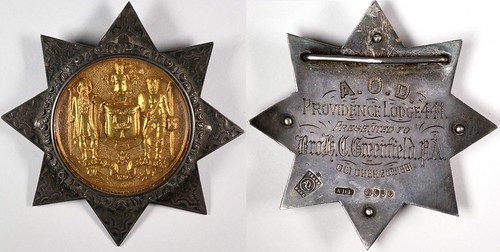
Eight pointed badge with covered portrait on obverse. Reverse engraved: A.O.D. / Providence Lodge 441 / Presented to / Bro. H. C. Greenfield, P.A. / October 20th 1881. Trade mark and silver smiths markings. Three inches across. Rare.
Interesting. Who were the Ancient Order of Druids? -Editor
To read the complete lot description, see:
Ancient Order of Druids Badge (124032)
(https://holabirdamericana.liveauctiongroup.com/Ancient-Order-of-Druids-Badge-124032_i38783754)
Lot 2177: U. S. Assay Office, San Francisco Ingot
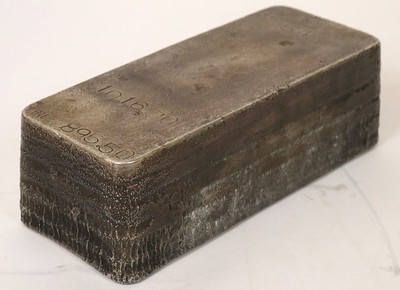
Large silver ingot, 11-3/4 x 4-3/4 x 3-7/8 inches. The product of five pours. Stamped weight is 1016.70 troy ozs, 895.50 fine. "U. C. 54" Probably the client initials and serial number. The ingot comes from the 1940s, held by the same family. It came to us in an old Farmers Merchants Bank, Lodi cloth bank bag. The USAO SF pattern is the small oval with eagle. See photos for condition and details.
That's some ingot! -Editor
To read the complete lot description, see:
U. S. Assay Office, San Francisco 1016.70 Troy Oz Silver Ingot (125540)
(https://holabirdamericana.liveauctiongroup.com/U-S-Assay-Office-San-Francisco-1016-70-Troy-Oz-Silver-Ingot-125540_i38783826)
Lot 2184: U. S. Navy Mounted 1891 Silver Dollar
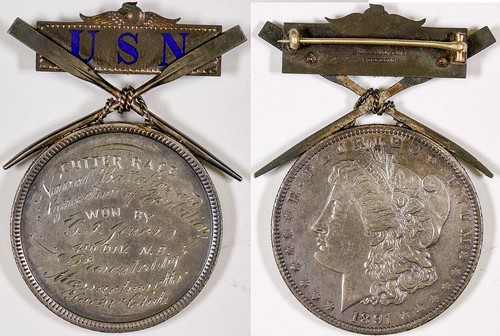
U.S. Navy mounted 1891 silver dollar, reverse engraved “CUTTER RACE / Naval Battalion and / Squadron of Evolution. / WON BY / G. F. Jones, / 4TH DIV. N. B / PRESENTED BY / Massachusetts’ / Yacht Club. After falling behind at the start of the race on July 8, 1891, the crew manning the oars of the 4th Division’s cutter pulled ahead and won. It is likely that each of the 13-man crew received a similar naval award. EF, PVC residue.
Interesting and unusual item. -Editor
To read the complete lot description, see:
U. S. Navy Mounted 1891 Silver Dollar - Cutter Race
(https://holabirdamericana.liveauctiongroup.com/U-S-Navy-Mounted-1891-Silver-Dollar-Cutter-Race-126192_i38783833)
Lot X2233: Wells Fargo, State of Nevada $5 Scrip
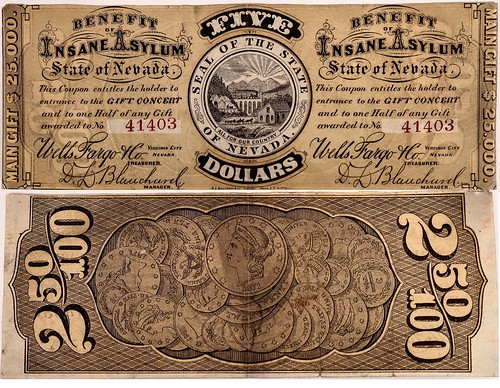
Extremely rare scrip note issued at Wells Fargo, Virginia City, Nevada. The note shows $5 scrip denomination on the front and a $2.50 denomination at each end of the back, indicating the note can be torn in half and redeemed for $2.50 for each half. The serial number and all the info is duplicated left to right. The note has been trimmed. This example is one of two known, the other a ragged example sold by us in 2015. The bottom edge of the note originally showed the purported date of the concert as August 15, 1872, but it was postponed to Feb. 1, 1873. Exceptional piece of Virginia City history.
Great item! I'd never seen one of these before. -Editor
To read the complete lot description, see:
Wells Fargo, State of Nevada $5 Scrip
(https://holabirdamericana.liveauctiongroup.com/Wells-Fargo-State-of-Nevada-5-Scrip-125052_i38783882)
Lot 2252: Carson City Mint Stereo View

You don't see this every day! Employees of the Mint (we assume) standing in front. Spotting. Please see photo. The Carson City Mint was a branch of the United States Mint in Carson City, Nevada. It primarily minted silver coins; however, it also minted gold coins, with a total face value in dollars nearly equal to that of its silver coins. The mint minted coins in 21 different years. The Carson City Mint was created in 1863 but was not put into operation until 1870. It ran until 1885, went on a hiatus, and resumed operations in 1889, after which it ran until 1893, when it closed permanently. It is now the Nevada State Museum, Carson City.
Wow! Great item of numismatic ephemera and a super image of the mint building. -Editor
To read the complete lot description, see:
Extra Rare Carson City Mint Stereo View (123465)
(https://holabirdamericana.liveauctiongroup.com/Extra-Rare-Carson-City-Mint-Stereo-View-123465_i38783901)
Lot 3319: Wells Fargo and Company Stock Certificate
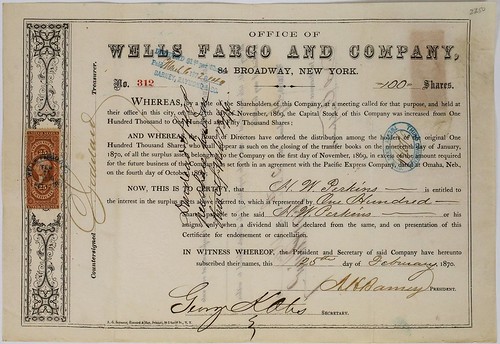
Ultra rare. This is from the period after the "Grand Consolidation" of 1866 when Wells Fargo, Holladay, and Overland Mail stage lines were united under the Wells Fargo name, and the company began its domination of Western stagecoach express and banking.
No. 312, issued for 100 shares to HW Perkins on February 25th, 1870. Signed by Ashbel Barney as president, C. Goddard as treasurer, and George K. Otis as secretary. Pen cancelled. Tied 25 cent adhesive revenue stamp on the front. A second stamp on the reverse. Pinholes, folds, creases. 8.25 x 12" Ashbel Barney served as president 1869-1870. He was the brother of Danford Barney, who was also involved with Wells Fargo from the beginning. The two also formed the United States Express Company.
Great item associated with the West and American banking. -Editor
To read the complete lot description, see:
Wells Fargo and Company Stock Certificate (113665)
(https://holabirdamericana.liveauctiongroup.com/Wells-Fargo-and-Company-Stock-Certificate-113665_i38784731)
Lot 3380: Boston Base Ball Association Stock Certificate

Ultra-rare. This is a significant piece of baseball history. Low cert. number 9, issued for two shares to FG Webster on January 29th, 1873. Signed by Charles Porter as president and Frederick Long as treasurer. Not cancelled. Black border and print. Five cent adhesive revenue stamp attached at bottom left. Folds, toning on left border. 5.25 x 8.75" The Boston Base Ball Association was the corporation that entered the Boston Red Stockings baseball team to compete for the National Association championship. They won the championship in 1873 (the year this stock was issued). The Boston Red Stockings eventually became the Atlanta Braves. Charles Porter was a descendant of the original Pilgrims that settled Massachusetts. He served as company president for only 1873 and helped lead the organization back into financial profitability. You won't find many baseball items earlier than this!
A very cool item for baseball collectors. -Editor
To read the complete lot description, see:
Boston Base Ball Association Stock Certificate (113677)
(https://holabirdamericana.liveauctiongroup.com/Boston-Base-Ball-Association-Stock-Certificate-113677_i38784792)
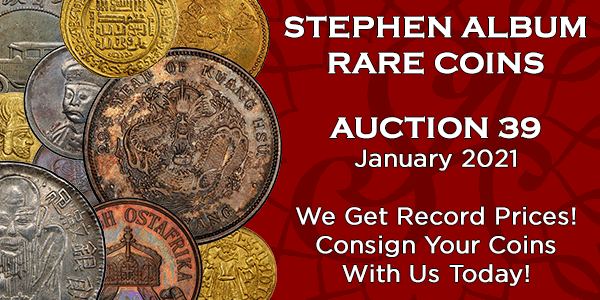
ARCHIVES INTERNATIONAL AUCTION 62 SELECTIONS
Here's a selection of lots that caught my eye in the October 29, 2020 sale by Archives International Auctions. -Editor
Lot 50: Chile 20 Pesos Specimen Note

Concepcion, Chile.... Specimen 20 Pesos, ND (ca. 1883), P-S180s. S/N D-00000, Specimen overprints, POC's, PMG graded Choice Uncirculated 64 with comment "Previously Mounted" (Cert # 8012570-008). ABNC.
Colorful piece. -Editor
To read the complete lot description, see:
Banco de Conception. ND (ca. 1883) Specimen Banknote.
(https://auction.archivesinternational.com/Banco-de-Conception-ND-ca-1883-Specimen-Banknote_i38779693)
Lot 62: 1914 China Bank of Communication Specimen Banknote

China. 1914, 1 Yuan, P-116s1 S/M#C126, Specimen banknote with no place name. Purple and m/c on face with locomotive through gorge in middle, back purple with steamship in rough seas. Specimen banknotes with ñ000000î serial numbers, POC's and Red SPECIMEN in English. PMG graded Gem Uncirculated 65 EPQ. ABNC. This is the base note for branch issues from Tientsin; Foochow/Amoy; and, Shanghai. Rare and unlisted as a specimen.
Another colorful piece. -Editor
To read the complete lot description, see:
Bank of Communication, 1914 Specimen Banknote
(https://auction.archivesinternational.com/Bank-of-Communication-1914-Specimen-Banknote_i38779705)
Lot 97: 1907 China One Silver Dollar Local Currency

Kiukiang/Nanking, China, 1st July 1907, $1 (One Silver Dollar Local Currency), P-S1180f S/M#C107-30f. Issued banknote, Orange-brown and black on face with Dragon, also an oval red seal with "Kiukiang" in English, back in orange-brown with portrait of man with hat in middle, flags at right, Low S/N 64, PMG graded Fine 12, Rare note in any form or condition. Only 2 notes are listed graded in the PMG census for this type and there have been no previous auction sales of this type on Track and Price.
Interesting and unusual. -Editor
To read the complete lot description, see:
Kiangnan Yu-Ning Government Bank, 1907, "1 Dollar" Issue Banknote Rarity
(https://auction.archivesinternational.com/Kiangnan-Yu-Ning-Government-Bank-1907-1-Dollar-Issue-Banknote-Rarity_i38779740)
Lot 148: 1797 France Tresorerie National

France, 1797, 200 Livre, Issued, S/N 14548, PMG graded Very Fine 30 with a small pin hole in center. Rare note rarely seen at auction.
Great note. -Editor
To read the complete lot description, see:
Tresorerie National, Recepisse, 1797 Banknote Issue.
(https://auction.archivesinternational.com/Tresorerie-National-Recepisse-1797-Banknote-Issue_i38779791)
Lot 275: Portugal 50 Escudos
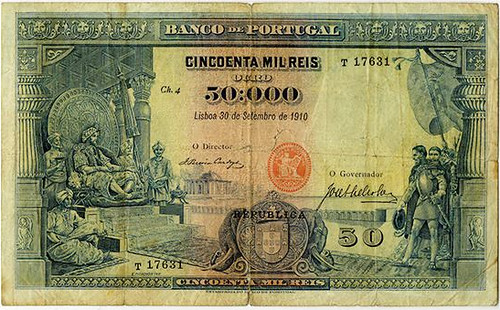
Portugal. ND (1917 - old date 1910), 50 Escudos, P-110, REPUBLICA overprint, PMG graded Very Fine 20 with note of splits and with small hole in middle. Rare with only 6 notes graded in the PMG census.
To read the complete lot description, see:
Banco de Portugal, 1910 (ND 1917), Issued Banknote Rarity
(https://auction.archivesinternational.com/Banco-de-Portugal-1910-ND-1917-Issued-Banknote-Rarity_i38779918)
Lot 864: $10 Liberty Loan Bond Participation Certificate
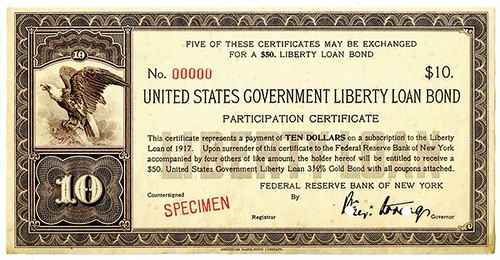
New York and Washington, D.C., 1917. Federal Reserve Bank of New York. $10 Specimen United States Government Liberty Loan Bond, Participation Certificate. Text on bond states: Five of these certificates may be exchanged for a $50 Liberty Loan Bond. "This certificate represents a payment of $10 on a subscription to the Liberty Loan of 1917. Upon surrender of this certificate to the Federal Reserve Bank of New York accompanied by four others of like amount, the holder hereof will be entitled to receive a $50. United States Liberty Loan 3 1/2% Gold Bond with all coupons attached". "Federal Reserve Bank of New York". Red specimen overprint, POC and "00000" serial numbers. Screaming Eagle at left. Red ink notation on top excess margin " Federal Reserve of New York", AU Condition. Rare Liberty Bond related item. ABNC.
Interesting bond-related ephemera. I don't believe I've heard of these before. -Editor
To read the complete lot description, see:
U.S. Government Liberty Loan Bond, 1917 Specimen 3 1/2% Gold bond Participation Certificates
(https://auction.archivesinternational.com/U-S-Government-Liberty-Loan-Bond-1917-Specimen-3-1-2-Gold-bond-Participation-Certificates_i38780507)
To read the earlier E-Sylum article, see:
ARCHIVES INTERNATIONAL AUCTION 62
(https://www.coinbooks.org/v23/esylum_v23n42a24.html)

COLTRANE WAR OF 1812 TREASURY NOTES
Stu Levine, Bruce Hagen, and Maureen Levine submitted this preview of paper money lots in the upcoming Heritage sale of the Mike Coltrane Collection. Thanks! Amazing notes. -Editor
Mike Coltrane’s intense interest in history and American paper currency inspired him to form the most comprehensive collection of War of 1812 United States Treasury Notes ever assembled. There are two main classes of notes. First are those authorized by the acts of June 30, 1812, March 4, 1814, and December 26, 1814 (and $100 notes from the February 24, 1815, act). They were in a large size format and paid 5-2/5% interest for one year from its hand-dated time of issuance. The second class of notes was authorized by the final act of February 24, 1815. These were in a “small” size format with denominations from $3 to $100, similar in size and style to slightly earlier first Bank of the United States notes. These did not pay set interest or have a set term, but were redeemable later for 7% United States funded stock. They circulated in commerce when signed by three officials including the register of the treasury or an authorized, designated official such as a commissioner of United States loans or other official designee.
All War of 1812 Treasury Notes share two common elements. First, they were all engraved and printed by Murray, Draper, Fairman & Co. in Philadelphia. Second, with one exception, the $3 denomination, all notes portrayed Federal eagle vignettes which symbolized American strength and resolve from its founding onward. The only note type without an eagle vignette is also the only federally authorized “three dollar bill” which was in common usage by private banks at the time. The fully issued “triple-signature” $3 note offered in this sale (lot 25034) is the only example of its kind known and boasts an illustrious pedigree. This issued note is the model for the future Demand Notes emitted for financing the Civil War.
The first part of Mike’s extraordinary collection of War of 1812 rarities comprises 21 historic
notes. All lots are currently on Heritage Auctions preview at
HA.com/3575. The sale will be held
in Dallas with Session 1 (floor) on November 4 and Session 2 (online only) on November 5. Lot
viewing will be available by appointment only at Heritage’s Office in Dallas (October 26-
November 4); contact Jose Berumen at
JBerumen@ha.com or 214-409-1299. We invite you to
join currency experts Dustin Johnston, Sarah Miller, and Bruce Hagen for an interactive Zoom
video preview and discussion of the sale on Friday, October 30, 2020 at 12:00 P.M CT at
https://zoom.us/j/91822062913?pwd=RFlrS0E5WDQxWWd1NEhxMnU4V1dKUT09
.

Act of June 30, 1812 $100 5-2/5% Treasury Note. Hessler X69A, Fr. TN-2. Unsigned Remainder. PMG About Uncirculated 55
Extremely rare first series interest bearing note. None are known issued and this is one of the finest. Lot 25014.
To read the complete lot description, see:
United States - Act of June 30, 1812 $100 5-2/5% Treasury Note. Hessler X69A, Fr. TN-2. Unsigned Remainder.
(https://currency.ha.com/itm/war-of-1812/united-states-act-of-june-30-1812-100-5-2-5-treasury-note-hessler-x69a-fr-tn-2-unsigned-remainder-pmg-about-uncircul/a/3575-25014.s)

Act of March 4, 1814 $100 5-2/5% Treasury Note. Hessler X74C, Fr. TN-6. Double- Signature Remainder. PMG Choice Extremely Fine 45
Arguably the most important War of 1812 series type. There are only three intact notes known. This is almost fully issued, and it is the Friedberg plate note. Lot 25016.
To read the complete lot description, see:
United States - Act of March 4, 1814 $100 5-2/5%Treasury Note. Hessler X74C, Fr. TN-6. Double-Signature Remainder.
(https://currency.ha.com/itm/war-of-1812/united-states-act-of-march-4-1814-100-5-2-5-treasury-note-hessler-x74c-fr-tn-6-double-signature-remainder-pmg-choice/a/3575-25016.s)
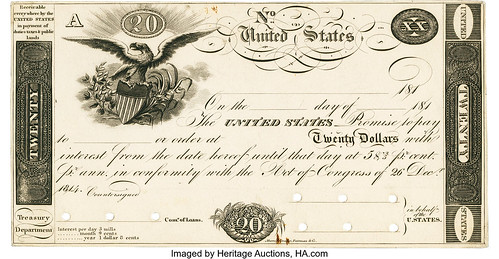
Act of December 26, 1814 $20 5-2/5% Treasury Note. Hessler X80A, Fr. TN-9p. Proof. PMG Choice Uncirculated 63
The first War of 1812 $20 treasury note. This is one of several important proofs from the collection. Its prestigious pedigree includes Joel Anderson and it is plated in two references. Lot 25017.
To read the complete lot description, see:
United States - Act of December 26, 1814 $20 5-2/5% Treasury Note. Hessler X80A, Fr. TN-9p. Proof.
(https://currency.ha.com/itm/war-of-1812/united-states-act-of-december-26-1814-20-5-2-5-treasury-note-hessler-x80a-fr-tn-9p-proof-pmg-choice-uncirculated-63/a/3575-25017.s)

Act of February 24, 1815 $50 Treasury Note. Hessler X83E, Fr. TN-11p. Proof. PMG Gem Uncirculated 65 EPQ
The Federal-style eagles engraved for the issue were highly crafted by Murray, Draper, Fairman & Co. This proof has been off the market since 2000 and is one of three known. Lot 25027.
To read the complete lot description, see:
United States - Act of February 24, 1815 $50 Treasury Note. Hessler X83E, Fr. TN-11p. Proof.
(https://currency.ha.com/itm/war-of-1812/united-states-act-of-february-24-1815-50-treasury-note-hessler-x83e-fr-tn-11p-proof-pmg-gem-uncirculated-65-epq/a/3575-25027.s)

United States - Act of February 24, 1815 $3 Treasury Note. Hessler X83A, Fr. TN-16b. Triple-Signature Fully Issued. PMG Very Fine 25.
This fully issued $3 note, signed by Joseph Nourse as register, is a landmark piece hailing back to F.C.C. Boyd’s collection. It was last auctioned 15 years ago. Lot 25034.
To read the complete lot description, see:
United States - Act of February 24, 1815 $3 Treasury Note. Hessler X83A, Fr. TN-16b. Triple-Signature Fully Issued.
(https://currency.ha.com/itm/war-of-1812/united-states-act-of-february-24-1815-3-treasury-note-hessler-x83a-fr-tn-16b-triple-signature-fully-issued-pmg-very-f/a/3575-25034.s)
To read the earlier E-Sylum articles, see:
COLTRANE COLLECTION SELECTIONS PART 1
(https://www.coinbooks.org/v23/esylum_v23n41a22.html)
COLTRANE COLLECTION SELECTIONS: BACK DESIGNS
(https://www.coinbooks.org/v23/esylum_v23n42a25.html)

PARTRICK COLLECTION OF CONNECTICUT COPPERS
Here's an article from the October 20, 2020 Coin News from Heritage about their upcoming sale of the Don Partrick collection of Connecticut coppers. -Editor

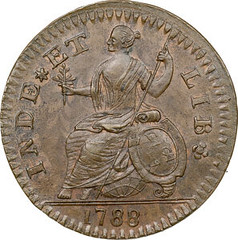
One of the most memorable U.S. Coin auctions of all time may well have been Heritage's January 2015 presentation of Donald G. Partrick's extraordinary United States colonials. In that unprecedented sale, 355 lots realized a total of nearly $26 million - a remarkable result yet, incredibly, only a small portion of Mr. Partrick's holdings. Now, we are thrilled to present the rest of this amazing collection in a series of specialized auctions, starting with the renowned Partrick 1785-88 Connecticut coppers. Bidding is open now and continues through the live session at 5PM CT on Sunday, November 1.
These Connecticut coppers were assembled over several decades with the guidance of trusted advisor Jon Hanson. Many of the coins have been unseen at public auction for more than 40 years.
While no one has ever formed a complete set of Connecticut die marriages, the variety count in the Partrick collection eclipses any other known set, with the exception of the ANS Connecticut Copper Collection. It exceeds historic collections such as Bowers, Taylor, Twin Leaf, Perkins, SLT, Ford, and many other fine collections offered over the years.
Representing well over 300 die marriages, the Partrick Collection includes more than one example of many challenging varieties, bringing the collection's total to 505 lots. While we are aware of a few current collections that are formidable in their own right, those sets are still under construction. Many Partrick coins are sure to find a home within today's finest collections.
The Donald G. Partrick Collection of Connecticut Coppers includes two varieties believed to be unique by die marriage - the 1787 Draped Bust Left Miller 33.22-II, W-3705, certified VG8 NGC, and the equally famous Draped Bust Left Miller 37.4-RR., W-4120 VF20 NGC. The collection offers a number of R.8 coins, including a pair of Mailed Bust Right varieties: The Large Head M. 2.3-T, W-2485, graded Fine 15 NGC, and the Scholar's Head M. 3-D.4, W-2515, certified AG3 NGC, as well as a Mailed Bust Left M. 8-a.1, W-2845, graded Fine 12 NGC, and a Draped Bust Left M. 33.36-T.3, W-3905, certified XF40 NGC.
Precious few high-grade Connecticut coppers survive regardless of variety, although the incomparable Partrick Collection includes no less than 20 pieces in Select Uncirculated (MS63) or finer grades. In total, more than 100 Mint State and nearly Mint State coins join many high Condition Census examples throughout the collection, with the following as just a taste:
- 1785 Connecticut, Mailed Bust Right, M. 6.3-G.1, W-2400, R.3, MS63 Brown NGC
- 1785 Connecticut, Mailed Bust Right, M. 6.5-M, W-2430, High R.6, MS62 Brown NGC
- 1787 Connecticut, Laughing Head, M. 6.1-M, W-2820, R.1, MS64? Brown NGC
- 1787 Connecticut, Draped Bust Left, M. 33.6-KK, W-3425, R.2, MS63 Brown NGC
- 1787 Connecticut, Draped Bust Left, M. 33.20-Z.11, W-3670, High R.6, AU53 NGC
- 1787 Connecticut, Draped Bust Left, M. 48-g.5, W-4315, R.5, MS64 Brown NGC.
- 1788 Connecticut, Mailed Bust Right, M. 3-B.1, W-4410, High R.5, MS64 Brown NGC
- 1788 Connecticut, Mailed Bust Left, M. 12.2-E, W-4530, R.6, MS61 Brown NGC
- 1788 Connecticut, Draped Bust Left, M. 16.4-L.2, W-4620, R.5, MS61 Brown NGC
Bidding is open now and continues at Coins.HA.com until the November 1 auction date. U.S. colonial enthusiasts and Connecticut copper specialists will be watching and bidding in record numbers for the chance to acquire some of the greatest Connecticut coppers known.
To view the auction lots, see:
https://coins.ha.com/c/search-results.zx?N=3183+793+794+791+1577+792+2088+4294944718&type=collectorb-1-coinus-news-tem102020

READING ANCIENT GREEK COINS
Mike Markowitz published a very useful CoinWeek article on reading inscriptions and dates on ancient Greek coins. Here's an excerpt - see the complete article online. -Editor
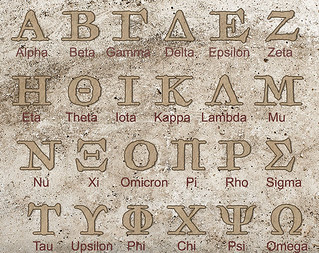 MODERN AMERICAN COINS are required by law to include quite a lot of text.
MODERN AMERICAN COINS are required by law to include quite a lot of text.
In contrast, ancient Greek coins are remarkably laconic.
Many bear no inscription at all — the technical numismatic term for this (from Greek, of course!) is “anepigraphic”. We can only guess at the level of literacy in the ancient Greek-speaking world. By one estimate, about five to 10 percent of the adult male population could read and write (Harris, 114). Several non-Greek societies (Celtic, Semitic, and Persian) used Greek letters for their coin inscriptions. Ancient Greek coin inscriptions are all written in “capital” letters; lower case letters were a post-Classical development used mainly in manuscripts. There were usually no spaces between words.

To read the complete article, see:
Reading Ancient Greek Coins
(https://coinweek.com/ancient-coins/reading-ancient-greek-coins/)
THE BOOK BAZARRE
TOURIST FINDS MEDIEVAL SILVER COIN CACHE
A tourist visiting Trnava Slovakia discovered a hoard of medieval silver coins beneath an uprooted tree. Nice find. -Editor
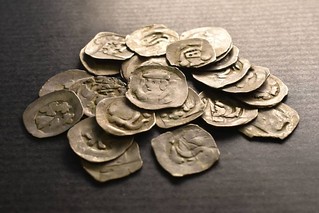 A tourist found silver coins from the 13th and 14th centuries under an uprooted tree near Piešťany.
A tourist found silver coins from the 13th and 14th centuries under an uprooted tree near Piešťany.
He has reported it to the Regional Monuments Board (KPÚ) in Trnava. Its workers found 147 middle-age silver coins after searching with a detector. The coins are mostly Wiener pfennigs but there are also Hungarian imitations of Wiener pfennigs that were minted in the years 1251 and 1330.
The coins were probably stored in a leather or fabric wrapper, Matúš Sládok of KPÚ Trnava opined, but there were no traces left of the wrapper.
An expert will now estimate the value of the discovery. The tourist who found the coins has asked for a finder’s fee.
To read the complete article, see:
Tourist finds ancient silver coins under an uprooted tree
(https://spectator.sme.sk/c/22511965/tourist-finds-ancient-silver-coins-under-an-uprooted-tree.html)
Found via The Explorator newsletter. To subscribe to Explorator, send a blank email message to: explorator+subscribe@groups.io. -Editor
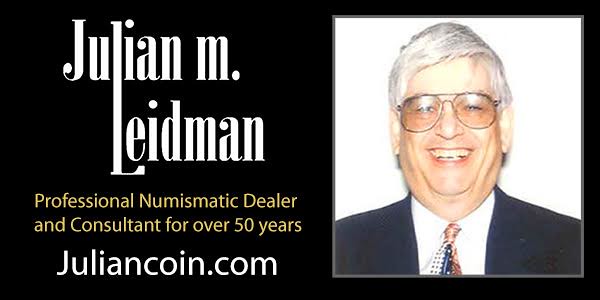
SILVER PENNY OF BARON EUSTACE FITZJOHN
Dix Noonan Webb are offering a rare silver penny of Baron Eustace Fitzjohn discovered recently by a metal detectorist. Here's the press release. -Editor
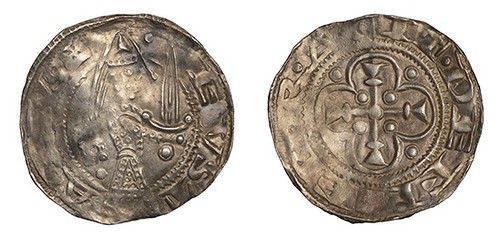
An extremely rare silver penny of Baron Eustace Fitzjohn, a 12th century Yorkshire Business Magnate has been discovered recently by a metal detectorist and is to be offered by International coins, medals, banknotes and jewellery specialists Dix Noonan Webb in a live/online auction of Coins and Historical Medals on Tuesday, November 3, 2020 at 10am on www.DNW.co.uk. The coin, which measures 19mm in diameter, was minted in York is one of only 20 surviving examples with this design and is estimated to fetch £10,000- 15,000.
On August 15, Rob Brown a 56-year-old from Leeds, was using his Deus XP metal detector on a stubble field near Pickering in North Yorkshire when on arriving and walking just 20 paces he got his first signal of the day. At a depth of just two inches in a clump of soil, he saw the edge of a silver coin which on closer inspection had a design on one side of a standing helmeted knight holding a sword. Around this is an inscription which reads EUSTACIUS. On the reverse is a cross within a quatrefoil with the legend EBOR. ACIT. DEFT.
 Rob did not initially recognise the coin which is a very rare silver penny issued in York by
Eustace Fitzjohn, the Lord of Malton and Knaresborough who served under King Henry I
becoming a wealthy landowner through marriage and then supporting the Empress Matilda
when she fought a civil war with her cousin Stephen in the period known as the anarchy in
England. There is a fortification which dates from this conflict near the coins find spot.
Rob did not initially recognise the coin which is a very rare silver penny issued in York by
Eustace Fitzjohn, the Lord of Malton and Knaresborough who served under King Henry I
becoming a wealthy landowner through marriage and then supporting the Empress Matilda
when she fought a civil war with her cousin Stephen in the period known as the anarchy in
England. There is a fortification which dates from this conflict near the coins find spot.
As Rob, who has been metal-detecting for 8 years, explained: “I was detecting with a friend and we found the coin, we weren’t sure if it was Saxon or Viking, so put a picture on a Facebook page devoted to milled and hammered coins – lots of people were reacting and were very excited – many knew instantly who/ what it was!”
In 1138, Eustace lost custody of Bamburgh Castle to Stephen and decided to join forces with David I of Scotland fighting with him against Stephen at the battle of the standard that year. In July 1157 Eustace was killed in Flintshire after being ambushed by the Welsh army.
Nigel Mills, Expert in Artefacts and Antiquities at Dix Noonan Webb, commented: “Baron Eustace Fitzjohn was a Justician of the north and became a great monastic patron. He was to some extent, the Baron Alan Sugar of his day coming from a humble background but achieving great wealth and prominence. As it was a period of Civil War, Baron Fitzjohn had the authority to have coins struck in York which were primarily for local use.”
To visit the Dix Noonan Webb website, see:
https://www.dnw.co.uk/

MAINE METAL DETECTORIST FINDS 1798 LARGE CENT
Here's a story from a local media outlet in Maine about a man's find of a 1798 cent. -Editor

If you spend enough time in some of traveling around Maine, you'll likely come across a treasure hunter. They're easy to laugh off, often times laser-focused with their metal detectors while everyone else around them is in relaxation mode. And while the take may generally be junk to most, every now and again, a treasure hunter finds exactly what they were looking for. That seems to be the case with one treasure hunter who recently spent some time in the Embden, Maine area.
Perhaps the most impressive portion of this find is the way the treasure hunter noticed that what they found was worth spending the time to rehabilitate. As you can see in the photo above, the initial find is almost undistinguishable as a 200+ year old penny. After the cleaning job, it truly is a piece of historic treasure.
And in case you're wondering, this treasure found a few other interesting items while on the hunt in rural Maine.
The article states that "coins like this ... can fetch as much as $3,000 dollars at auction..." but of course it would be a different story for a cleaned dug coin in this condition. Still a fun find. -Editor
For other Maine finds, see:
Rural Maine homestead delivers; wagon wheel, large cent (1818?) and musket ball!
(https://www.reddit.com/r/metaldetecting/comments/j38tea/
rural_maine_homestead_delivers_wagon_wheel_large/)
To read the complete article, see:
A 222-Year-Old Coin Was Unearthed In A Small Maine Town
(https://wcyy.com/a-222-year-old-coin-was-unearthed
-in-a-small-maine-town/)

LITHUANIA EURO COIN WITH HEBREW LETTERS
Arthur Shippee and Howard Berlin passed along this Jerusalem Post article about a new Lithuanian coin with Hebrew lettering. Thanks. -Editor
The Bank of Lithuania minted the first euro piece of currency containing Hebrew letters.
The 10-euro coin was minted on Tuesday and is a limited-edition commemorative collector’s item celebrating the 300th anniversary of the birth of the Vilna Gaon, the 18th-century rabbinical luminary Elijah ben Solomon Zalman, who lived and died in the Lithuanian capital of Vilnius.
The heads side of the coin features the Hebrew letter shin, whose value according to the gematria alphanumeric code is 300, followed by the acronym in Hebrew of Gaon Rabbi Elijah. The tails’ rim reads in Hebrew: “The year of the Vilna Gaon and the history of the Jews of Lithuania.”
The commemoration of individual people is very rare on banknotes and coins of the European Union, partly because of the political sensitivity in a political union made up of former foes.
To read the complete article, see:
Lithuania mints first euro coin with Hebrew letters
(https://www.jpost.com/diaspora/lithuania-mints-first-euro-coin-with-hebrew-letters-646773)
The JP article didn't picture the coin, but I found an image elsewhere. -Editor
 The reverse of the coin dedicated to the Vilna Gaon depicts ? – the Hebrew crown-shaped letter Shin which in gematria represents the number 300, and גר"א – an acronym for “Ha Gaon Rabbi Elyahu”, meaning “Gaon (Genius) Rabbi Elijah”. The bottom of the coin features a symbolic Torah scroll with the engraved number 300. The reverse also bears the inscriptions “the Vilna Gaon” and “Rabbi Elijah ben Solomon Zalman” in the Lithuanian and Hebrew languages.
The reverse of the coin dedicated to the Vilna Gaon depicts ? – the Hebrew crown-shaped letter Shin which in gematria represents the number 300, and גר"א – an acronym for “Ha Gaon Rabbi Elyahu”, meaning “Gaon (Genius) Rabbi Elijah”. The bottom of the coin features a symbolic Torah scroll with the engraved number 300. The reverse also bears the inscriptions “the Vilna Gaon” and “Rabbi Elijah ben Solomon Zalman” in the Lithuanian and Hebrew languages.
The obverse of the silver coin depicts the sign of Lithuanian Jews (Litvaks) – a community identity symbol representing the identification of Lithuanian Jews, as citizens, with the state of Lithuania since the reign of Gediminas, Grand Duke of Lithuania. The main design of the coin is surrounded by the inscription “The Year of the Vilna Gaon and the History of the Jews in Lithuania” in the Lithuanian and Hebrew languages as well as the number 5780 which stands for the year 2020 in the Jewish calendar. The edge of the coin bears the inscription “If you will it, you too can be a genius” in the Lithuanian and Yiddish languages.
To read the complete article, see:
Pre-orders of the coin dedicated to the Vilna Gaon start on 13 October
(https://www.lb.lt/en/news/pre-orders-of-the-coin-dedicated-to-the-vilna-gaon-start-on-13-october)

QUEEN’S BEASTS VS. AMERICA THE BEAUTIFUL
Lou Golino published a nice article on Coin Update comparing and contrasting two series of coins from the Royal Mint and United States Mint. Here's an excerpt, but be sure to read the complete article online. -Editor

Two major series of bullion and collector coins — the America the Beautiful (ATB) five-ounce silver quarters from the U.S. Mint, and the Royal Mint’s Queen’s Beast series — will soon end. Both have helped to reshape the market for modern bullion and collector coins in recent years and have been major sources of revenue for their respective mints.
Examining the similarities and differences between the two series may shed some light on what modern coin buyers are looking for and on what kinds of coins do well in the marketplace. This information may also be useful to world mints contemplating similar series that run for an extended period — something already happening in the U.S.
The ATB series with 56 designs of U.S. national parks and monuments ran for 11 years, while the Queen’s Beasts ran for only five years and included 10 stylized designs of the heraldic beasts made into statues which were present for the coronation of Queen Elizabeth in 1953. The Queen’s Beasts series consists of more coins in total because it has so many variants.
The ATB coins, issued in bullion (frequently with Prooflike and deep mirror Prooflike surfaces, especially as the series continued) and vapor-blasted collector versions with a “P” mintmark, were first struck late in 2010 (and released the following year), will end early next year with the coin for the Tuskegee Airman National Historic site in Alabama designed by Chris Costello.
The Queen’s Beasts have been issued in silver and gold bullion since 2016 and since 2017 in platinum and in a wide range of sizes in silver and gold Proofs also since 2017. The 10th and final design, the White Greyhound of Richmond, was released recently in silver and gold bullion versions.
To read the complete article, see:
The Queen’s Beasts vs. America the Beautiful: Comparing and contrasting two iconic modern coin series
(http://news.coinupdate.com/the-queens-beasts-vs-america-the-beautiful-comparing-and-contrasting-two-iconic-modern-coin-series/)
THE BOOK BAZARRE
KELLOGG & HUMBERT GOLD INGOT
The Holabird sale article elsewhere in this issue features a whopper silver ingot. Here's the press release for another big ingot - a gold SS Central America bar in an upcoming Heritage sale. Here's the press release. -Editor
Hefty, Historic Gold Bar Highlights November Auction
Heritage Auctions will be selling a great piece of shipwreck history as part of the November US Coin Auction #1321. The S.S. Central America shipwreck occurred in the 1850s and forever changed numismatic history. This 280-foot sidewheel ship regularly operated between Central American and the eastern coast of the United States in the 1850s until a hurricane in 1857 sunk the mighty boat, weighed down heavily with a huge treasure of gold coins and bars.
 Rather than these pieces arriving to their destination and being used in commerce, they sat for years at the bottom of the ocean--primarily in uncirculated condition but covered in corrosive seawater. Thanks to careful expeditions of divers with new technology and gentle conservation, these coins and bars were eventually recovered and made available to the collecting public. Many of the coins and bars are actually in amazing condition today, after conservation, because they were never spent and used in commerce.
Rather than these pieces arriving to their destination and being used in commerce, they sat for years at the bottom of the ocean--primarily in uncirculated condition but covered in corrosive seawater. Thanks to careful expeditions of divers with new technology and gentle conservation, these coins and bars were eventually recovered and made available to the collecting public. Many of the coins and bars are actually in amazing condition today, after conservation, because they were never spent and used in commerce.
Pieces that were rescued from the S.S. Central America are very popular with collectors today. Some of the most impressive items of all from this shipwreck were the massive gold bars that survived their watery journey in surprisingly excellent condition.
The lot up for bid in the November auction is a hefty 46.53 ounce gold bar, created by Kellogg & Humbert Assayers. The bar is stamped with what it would have been worth in terms of 1857 prices, or $887.79 in gold. Today, however, the bar will sell for over $100,000 today--a huge increase in price over the last 150+ years!
This bar, along with several other pieces of shipwreck history, was put together by a coin collector, scuba diver, and American patriot who became fascinated by the story of these coins' and bars' recovery from the watery depths. He pursued several top examples and is now sharing his collection with bidders as part of John's SS Central American Collection.
To read the complete lot description, see:
Kellogg & Humbert MS Gold Ingot. 46.53 Ounces. CAB...
(https://coins.ha.com/itm/s.s.-central-america-gold-ingots/ingots/kellogg-and-humbert-ms-gold-ingot-4653-ounces/p/1321-71002.s)

LOOSE CHANGE: OCTOBER 25, 2020
Here are some additional items in the media this week that may be of interest. -Editor
Wallis Simpson’s Lucky Silver Dollar?
Scott Miller passed along this auction lot without comment. -Editor
 An 1885 US silver dollar coin, carried by Duchess of Windsor Wallis Simpson in her handbag as a good luck charm. Measures 1.5 inches in diameter.
An 1885 US silver dollar coin, carried by Duchess of Windsor Wallis Simpson in her handbag as a good luck charm. Measures 1.5 inches in diameter.
The coin is accompanied by several unused notelets belonging to the Duchess, some printed with the words “From the desk of HRH The Duchess of Windsor”.
Cast-iron provenance from an unquestionable source: The coin was gifted to the vendor in the 1980s by Edward VIII’s impeccable personal butler Sydney Johnson.
While one might hold out for a solid-gold provenance, cast-iron's still pretty solid. -Editor
To read the complete lot description, see:
Wallis Simpson’s lucky silver dollar coin
(https://www.invaluable.com/auction-lot/wallis-simpsons-lucky-silver-dollar-coin-1-c-bc641bfa41)
Brazilian Senator Caught Hiding Cash
The news is awash in stories of people smuggling valuables in their nether regions. Here's the latest from Brazil. -Editor
A key ally of Brazil's president has been arrested after anti-corruption officers discovered a wad of banknotes in the underpants he was wearing.
Police initially found 10,000 reais (£1,380) and £4,650 inside a safe in Senator Chico Rodrigues' house during a search on Wednesday.
He then asked if he could go to the bathroom - and according to the police report, an officer noticed a large, rectangular bulge under the senator's shorts as he walked off.
He was targeted as part of an investigation into the alleged misappropriation of COVID-19 funds.
To read the complete article, see:
Politician stuffed £4,500 in the underpants he was wearing during raid by anti-corruption police
(https://news.sky.com/story/anti-corruption-police-discover-4-500-stuffed-in-underpants-of-senior-brazilian-politician-12105222)
To read the earlier E-Sylum article, see:
GOLD SMUGGLER CAUGHT AT INDIAN AIRPORT
(https://www.coinbooks.org/v23/esylum_v23n42a37.html)
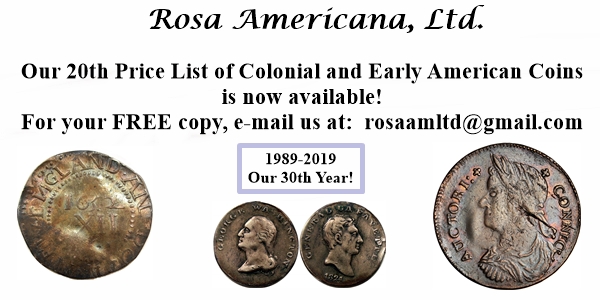
NEW BOOK: DARK ARCHIVE
Just in time for Halloween, Len Augsburger passed along this New York Times review of a truly creepy topic for bibliophiles and everyone - books bound in human skin. -Editor
 In her book, Rosenbloom takes us from library to library, recounting her conversations with other librarians, as well as with historians, collectors and medical students in the act of dissecting cadavers. She includes no shortage of memorable scientific minutiae and clarifications of misunderstood history along the way, including the fact that there’s no evidence that Nazis made books from human skin. (This was maybe the one abominable thing they didn’t do.)
In her book, Rosenbloom takes us from library to library, recounting her conversations with other librarians, as well as with historians, collectors and medical students in the act of dissecting cadavers. She includes no shortage of memorable scientific minutiae and clarifications of misunderstood history along the way, including the fact that there’s no evidence that Nazis made books from human skin. (This was maybe the one abominable thing they didn’t do.)
In fact, anthropodermic bibliopegy was not the practice of some singularly heinous regime. Such books were never common — Rosenbloom’s team has identified only about 50 alleged examples worldwide — but she suggests that the total number is plausibly far greater. Human skin leather looks indistinguishable from that of other mammals, and only recent developments in DNA sequencing technology have made it possible to tell a skin-bound book from a forgery.
The making and selling of such books was pursued at many times and in many places, including late-19th-century America. John Stockton Hough, a Philadelphia physician, is known to have bound three textbooks about reproduction in the skin of Mary Lynch, a local woman who died at 28 in 1869 of tuberculosis and a parasitic infection. During an autopsy, Hough removed and preserved skin from her thighs, and then bound his books with it — presumably as a form of homage. Struggling to make sense of this sort of bizarre behavior, Rosenbloom observes, “It’s easier to believe that objects of human skin are made by monsters like Nazis and serial killers, not the well-respected doctors the likes of whom parents want their children to become someday.”
 Rosenbloom does not spare us the details of the methods by which skin-bound books were made, right down to the techniques of tanning, soaking and scraping the “hides” to preserve them. At times her descriptions seem gratuitously to indulge the same morbid fascination that has long drawn people to these objects. But she finds a way to indulge that fascination without the exploitation inherent in the books’ production. Despite their gory history, Rosenbloom suggests, something draws us to behold physical proof of “what happens when immortality is thrust upon us.”
Rosenbloom does not spare us the details of the methods by which skin-bound books were made, right down to the techniques of tanning, soaking and scraping the “hides” to preserve them. At times her descriptions seem gratuitously to indulge the same morbid fascination that has long drawn people to these objects. But she finds a way to indulge that fascination without the exploitation inherent in the books’ production. Despite their gory history, Rosenbloom suggests, something draws us to behold physical proof of “what happens when immortality is thrust upon us.”
To read the complete article, see:
Yes, Books Were Bound in Human Skin. An Intrepid Librarian Finds the Proof.
(https://www.nytimes.com/2020/10/20/books/review/dark-archives-megan-rosenbloom.html)
To read an earlier E-Sylum article, see:
MORE BOOKS BOUND IN HUMAN SKIN
(https://www.coinbooks.org/esylum_v19n18a31.html)

FEATURED WEB PAGE: PERUVIAN BANKNOTES
This week's Featured Web Page is an overview of current Peruvian banknotes from the site of the Peru Telegraph.
The current banknotes of Peru are not only lovely with famous Peruvian personalities on the front and amazing archaeological sites on the back passing on Peru's extensive cultural past; Peru’s bills also have a high technical sophistication and top-notch security features which together with their beautiful design earned the notes the one or other award.
Since 1991 the Peruvian currency is the “Nuevo Sol” (S/.), which was renamed to just “Sol” (S/) in 2016 - plural (Nuevos) Soles. Its international code is PEN. There are banknotes for S/ 10, S/ 20, S/ 50, S/ 100 and S/ 200.

https://www.perutelegraph.com/peru-information/peruvian-money/current-peruvian-banknotes


